Research Symposium - Monday, November 18, 2013
An Undergraduate Materials Laboratory Hydrogen Diffusion Experiment
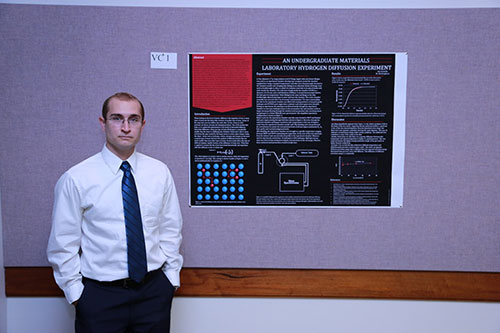
Alex Kratville and Glen Longhurst*, PhD
Department of Integrated Engineering
Abstract
Diffusion of hydrogen through metals at elevated temperatures is an important topic in tritium systems and hydrogen powered vehicles. Teaching diffusion in undergraduate materials laboratories is benefited by first-hand experience in permeation measurements. An experiment to demonstrate hydrogen permeation through a stainless steel tube was assembled. The purpose of this work was to determine how well the results of that experiment agreed with prominent literature values for diffusivity and solubility of hydrogen in stainless steel. Hydrogen mixed with argon was admitted to a heated canister containing a coiled 316 stainless steel tube. Pure argon sweep gas was passed through the tube to a mass spectrometer where composition transients of pertinent gas species were recorded. Fits of a theoretical transient model to the experimental data gave values of diffusivity and solubility of hydrogen in the stainless steel. Tests were conducted at hydrogen driving pressures ranging from 0.01 to 0.5 atm. and temperatures from 700 to 783 K. The form of the permeation transient data was fit well by the theoretical model. Observed values of diffusivity and solubility of hydrogen in the stainless steel from these transients were similar to literature values with some differences. The differences may be explained in terms of known phenomena. The results of this experimental method are sufficiently close to published values of diffusivity and solubility to warrant the experiment’s use as a teaching aid. The method may be extended to other materials for research or demonstration purposes.
Achieving Outcomes Embracing Constructivist Developmental Theory
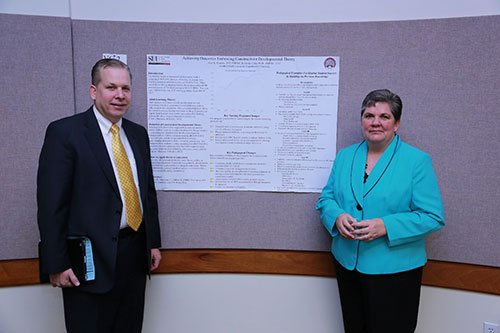
Alan Pearson, DNP, FNP-BC, Donna Lister, Ph.D, FNP-BC, CNE
Department of Nursing
Abstract
The SUU Nursing Program was developed with the underlying theoretical framework of Learner-Centered Education. Students engaged well in this learning process, but as a cohort, failed to gain individual factual knowledge necessary for success on NCLEX. Students progressed through the nursing program without being held accountable for factual information. Group learning activities were insufficient to demonstrate individual student knowledge. Analysis of poor student performance with standardized tests led nursing faculty to explore pedagogical change. Key elements within the Constructivist Development Theory provide insight into positive pedagogical changes that have proven successful for our graduates. This presentation highlights data trends with standardized testing used throughout the nursing program as well as NCLEX outcomes. This presentation provides support for work furthering the concept of Constructivist Development Theory with application to nursing education. Many theoretical models of nursing education attempt to provide a basis for nursing curriculum. The pedagogical changes made within the SUU Department of Nursing are consistent with Constructivist Development Theory and student outcomes consistently validate this concept.
Provider and Patient Education on the Signs, Symptoms, and Diagnostic Criteria of Inflammatory Breast Cancer
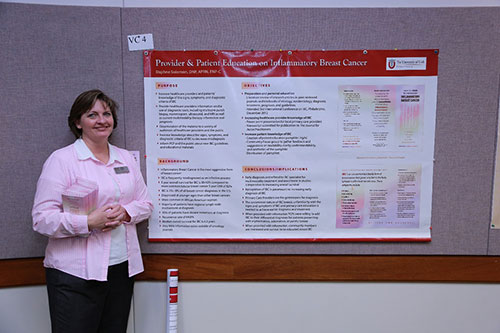
Daphne Solomon, DNP, FNP-C Dianne Fuller*, DNP, APRN, FNP-C; Debra Whipple*, DNP, FNP-BC; Ana Sanchez-Birkhead, PhD, WHNP-BC
Department of Nursing
Abstract
Inflammatory breast cancer (IBC) is the most aggressive and deadly form of breast cancer. IBC was once a universally fatal disease, but today the 5-year survival is 30-40% (Bond, Connoly, & Asci, 2010). IBC is 1% - 6% of all breast cancer diagnoses. Rarity breeds unfamiliarity in both providers and patients (Molckovsky et al., 2009). The majority of patients initially present to primary care providers (PCP). Misdiagnosis with breast cellulitis or mastitis often occurs with IBC. The majority of literature on IBC is published in oncology journals. Very little exists in primary care, gynecology, or internal medicine journals. A survey of medical and pathophysiology textbooks revealed scant information available to students of healthcare. The aim of this project was to increase both patient and PCP knowledge of the signs, symptoms, diagnostic criteria, and guidelines associated with IBC.
The Health Belief Model (HBM) was the theoretical framework for the project. Through PCP and patient education about IBC, this disease may be recognized and diagnosed earlier, eventually leading to a better prognosis.
Study of A1c and body fat among students, staff and faculty at Southern Utah University
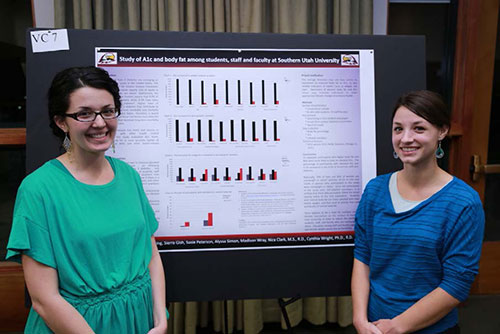
Alyssa Simon Beveridge, Madison Wray, Jessica Brown, Emily Clendening, Sierra Gish, Nica Clark*, Cynthia Wright, Ph.D.*
Department of Agriculture and Nutrition Science
Abstract
The Centers for Disease Control and Prevention reports 35.9% of all adults in the United States are obese, 8.9% are pre-diabetic, and 8.3% of the adults have diabetes.
The goal of this project was to determine if there was a relationship between body fat and elevated glucose levels and other health-related variables among students, staff and faculty on the campus of Southern Utah University. A convenience sample of 384 was recruited from the university population. Participants completed an IRB-approved survey and three measurements were taken: waist circumference, body fat, and A1c (an indicator of risk for developing diabetes).
Nearly five percent of participants were underweight, 26% were overweight, and 14% were obese. Results related to percent body fat revealed that as percent body fat increased, so did A1c levels, waist circumference, and age. Married participants were also more likely to have a higher percent body fat.
Nearly six percent of participants had an A1c above seven (considered elevated). Elevated A1c was related to marital status, and lack of satisfaction with both weight and physical health.
Developing Polymeric Separation Microdevices for Protein and Small Molecule Analysis
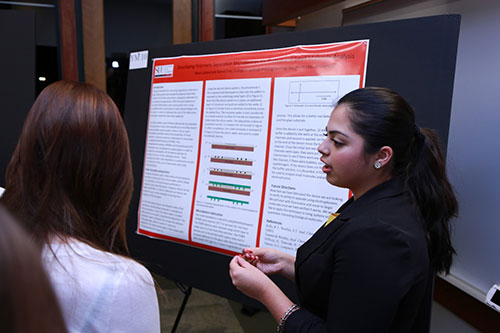
Rakul Lobana, Daniel J. Eves, Ph.D.*
Department of Physical science
Abstract
The advent of polymeric material use in microchip fabrication has made research in microfluidic separations more practical and efficient. We are fabricating microchips constructed from a poly(dimethyl siloxane) (PDMS) substrate using electrodeposited nickel templates to construct separation channels. The PDMS substrates are cleaned with scotch tape and exposed to UV radiation in an attempt to plasma clean the polymer. Once cleaned, the PDMS is added to a glass slide to form the bottom of the separation channel. The open format of these microfluidic devices allows for analysis of proteins and small molecules using both electrochemical and spectroscopic techniques.
Does Phophatidylserine-Cu 2+ Binding Cause Flipping?
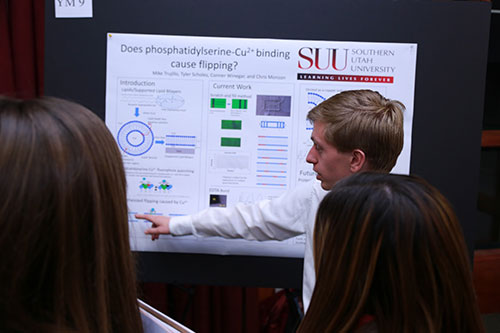
Mike Trujillo, Conner Winegar, Chris Monson, Ph.D.*
Department Of Physical Science
Abstract
We are investigating the behavior of phosphatidylserine (PS) lipids in the presence of copper. PS is present in the cell membrane of most living things, and has been linked to as important and diverse cellular processes as apoptosis, clotting, and disease transmission. Previous studies have demonstrated that copper (II) ions bind PS, and suggest that the copper-PS complex can "flip" across membrane bilayers. We have used electrophoresis and microfluidics and are currently using a copper-catalyzed reaction to attempt to demonstrate whether or not flipping of the complex actually occurs.
Expedient Synthesis of Monobactam Antibiotics by Visible Light Photocatalysis
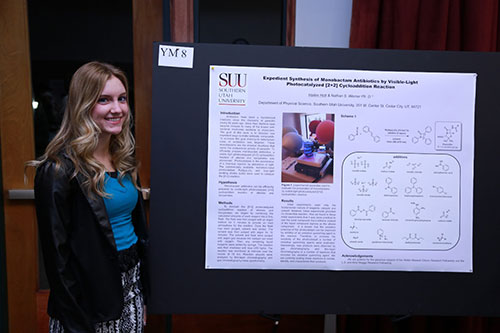
Hailee Holt and Dr. Nathan S. Werner, Ph.D.*
Department of Physical Science
Abstract
Organic compounds with antibiotic properties are a cornerstone of medicine and human health. This research is focused on the discovery of new expedient ways to synthesize antibiotic compounds from simple starting materials. To accomplish this goal a visible light photocatalyzed [2+2] cycloaddition reaction of alkenes and isocyanates was targeted for the production of monobactam antibiotics. Initial work focused on the development of productive reaction conditions between phenyl isocyanate and trans-stilbene. Later experiments were directed to increase the reactivity of the photocatalyst by the addition of a stoichiometric oxidative quencher. Multiple new products were detected by analysis of reaction mixtures that included oxidative additives. We currently work to isolate and characterize these new products.
Quantification of Tetrodotoxin Levels in Taricha granulosa
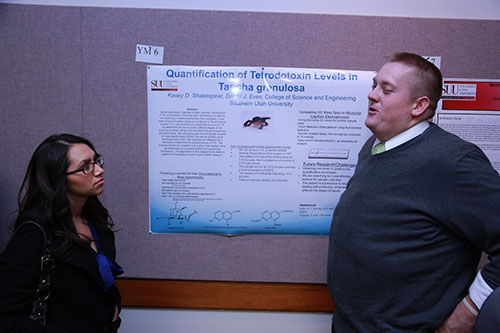
Kasey D. Shakespear and Daniel J. Eves, Ph.D.*
Department of Physical Science
Abstract
Taricha granulosa, a species of newt, excretes Tetrodotoxin (TTX), a neurotoxin, from their skin. Tetrodotoxin is used by the newts as a means of protection from predators. It has been shown that adult, larvae and embryos of Taricha torosa contain TTX. We would like to quantify the amount of TTX excreted from the newts at their different stages of life, including embryos, larvae (pre and post hind leg emergence) and adult newts. We will employ gas chromatograph coupled to mass spectrometry (GCMS) as well as capillary zone electrophoresis (CZE) with fluorescence detection on a microchip to determine the concentrations of TTX. The purpose behind our research is to confirm that capillary zone electrophoresis is a suitable platform for quantifying Tetrodotoxin. The application of this research is to obtain a baseline of Tetrodotoxin levels to aid in further research.
Identification and Mechanistic Studies into a Novel Reaction for Construction of Indoles and Carbazoles
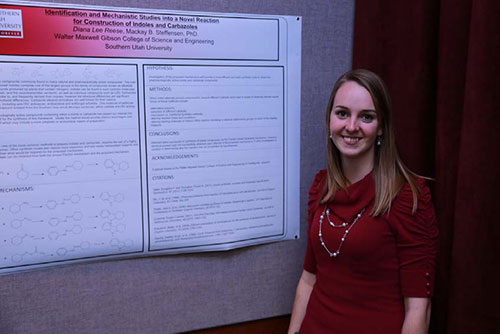
Diana Reese, Mackay B. Steffensen, PhD.
Department of Physical Sciences
Abstract
In looking at the well-known and well-characterized Fischer-Indole reaction a potential alternative pathway for the synthesis of indoles and carbazoles was identified. This proposed reaction hints at producing an intermediate identical to that involved in the Fischer process. If this convergence to a common intermediate occurs as anticipated, the proposed reaction should produce a product identical to that from the Fischer procedure. If proven true, a new chemical reaction will have been identified.
The proposed reaction for the synthesis of indoles (and eventually carbazoles) involves the coupling of an aromatic nitroso compound with a cyclic amine portion via a new mechanistic pathway. The scheme below outlines the proposed novel reaction. The convenience of this reaction would be manifested as fewer steps than other synthetic routes and the requirement of less-expensive and more easily manipulated reagents. The greatest potential benefit is not requiring the use of a highly toxic hydrazine as needed in the Fischer method.
This reaction was explored in various reaction conditions—including various solvents, various pH concentrations, microwave and traditional reaction methods, and even the use of differing catalysts.
This reaction has been explored, but unfortunately has not yet proven successful. The reason for this has not yet been identified. Further research is needed in determination of why the reaction has thus far proven unsuccessful and possible utilization of this information in an effective manner.
Simulating Lipid and Protein Movement in Membranes under Electrophoresis
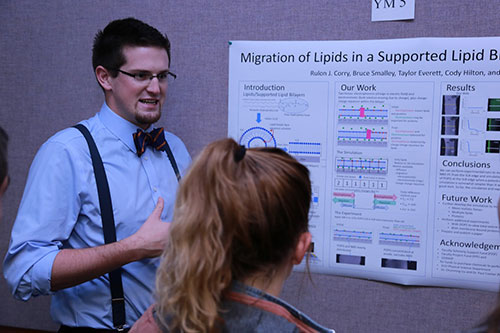
RJ Corry, Taylor Everett, Cody Hilton, Bruce Smalley, and Chris Monson, Ph.D.*
Department of Physical Science
Abstract
Cell membranes and their proteins play an essential role in everyday life and are of a particular interest to those studying life. There has been an increase in studies that look at the role of these proteins and membranes along with their interactions in drug and theoretical research. Recently, supported lipid bilayers (SLBs) have been used to purify membrane proteins using a technique called electrophoretic/electroosmotic focusing (EEF). While this technique is well-understood at the beginning and end of lipid/protein separation, the behavior of these lipids/proteins is not well understood in-between. We are attempting to create a computer simulation that will allow us to model the behavior of lipids and proteins in all stages of the separation. This is meant to help understand the interactions of proteins and lipids for future studies.
Synthesis and characterization of new Imines and their d8 Metal Complexes
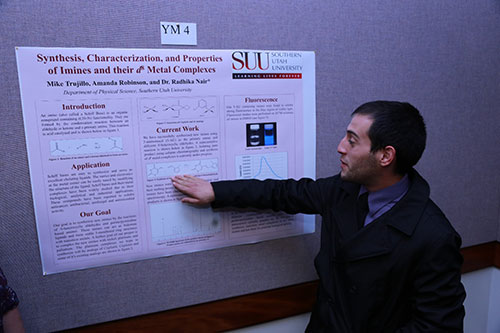
Michael Trujillo, Amanda Robinson, Radhika Nair, Ph.D.*
Department of Physical Science
Abstract
Imines are an important class of organic compounds containing (CH=N)) functionality. They are also called Schiff bases, named after Huge Schiff who synthesized them in 1864. They are synthesized by the condensation reaction between an aldehyde or a ketone, and an amine. Many imines show significant biological activities such as antibacterial, antiviral, and anticancer activities. Our goal is to synthesize new imines by the reactions of N-heterocyclic aldehydes and amines. These imines can act as bidentate ligands and form stable 5-membered ring structures with transition metals. A further goal of our project is to complex the new imines with d8 metals, namely nickel, platinum, and palladium. The platinum complexes we hope to synthesize will be analogs of Cisplatin, an anticancer agent. Once successfully synthesized, the metal complexes will be screened for this potential biological activity.
We have synthesized new imines of 5-aminouracil and three different N-heterocyclic aldehydes. 1H-NMR and IR spectral data have shown that we have synthesized the desired imines. Work is in progress to isolate pure products and synthesize their metal complexes. A useful property of our newly synthesized imines is that they are highly fluorescent in the blue region of visible light.
Synthesis of Amines Through an Alkyl Borane Intermediate
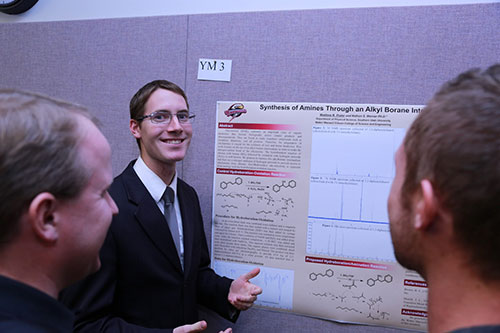
Matthew B. Prater and Dr. Nathan S. Werner, Ph.D.*
Department of Physical Science
Abstract
Alkylamines (RNH2) represent an important class of organic molecules that include biologically active natural products and pharmaceuticals. They are found in many important compounds such as morphine, dopamine, and all proteins. Therefore, the preparation of alkylamines is crucial for the synthesis of new and better medicines. This work focuses on the use of an alkyl borane intermediate in order to make the nitrogen-carbon bond of the alkylamine. The hydroboration reaction of alkenes with borane (BH3) followed by oxidation with hydrogen peroxide (H2O2) is well known. We propose to harness this alkylborane intermediate and then use a nitrogen equivalent of hydrogen peroxide to provide access to alkylamines from alkenes. Anti-Markovnikov site-selectivity is expected from analogy with the hydroboration oxidation reaction. The hydroboration oxidation control reaction has been successfully performed on trans-stilbene. The development of productive experimental conditions for the desired reaction is currently underway.
Synthesis of Trialkylphosphine Ligands for Use in Transition-Metal Catalyzed Reactions
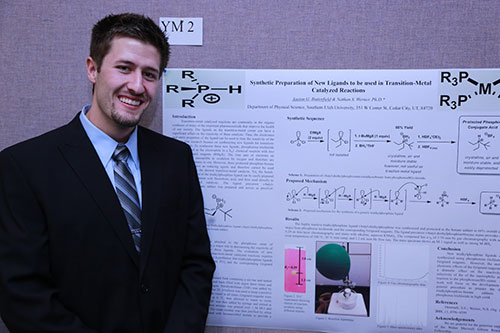
Auston G. Butterfield and Dr. Nathan S. Werner, Ph.D.*
Department of Physical Science
Abstract
Transition-metal catalyzed reactions are useful in the organic synthesis of pharmaceuticals, materials (plastics), and fuels. The structure and electronics of phosphine ligands coordinated to the transition-metal center can significantly affect the reactivity of the catalyst. This research focuses on the synthesis of new phosphine ligands to be used in novel transition-metal catalyzed reactions. The highly reactive trialkylphosphine ligand diethyl-tert-butylphosphine was synthesized and protected as the borane adduct in 66% overall yield (4-steps) from phosphorus trichloride and the corresponding Grignard reagents. The steric and electronic effects of the Grignard reagents was found to have a dramatic effect on the reactivity and selectivity of the 3-step nucleophilic addition reaction to the phosphorous(III) center. Future work will focus on the development of a general procedure to prepare the desired trialkylphosphine-borane adducts from phosphorus trichloride in high yield.
Microfluidic Device Fabrication Made Simple
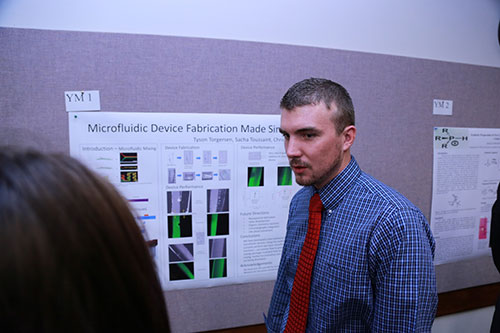
Tyson Torgersen and Chris Monson, Ph.D.*
Department of Physical Science
Abstract
We are developing a new method to create microfluidic devices using metallic wires as templates. Microfluidic devices are commonly used in medical and other routine testing, but high prototyping costs limit their use in less generalizable settings such as organic chemistry. Our method uses inexpensive materials (magnesium wire, PDMS, and HCl) to pattern and create microfluidic devices. We are testing the behavior of our microfluidic devices, and hope to soon move into testing organic reactions and developing further functionalities with our microfluidic devices.
3D Printers: The Future
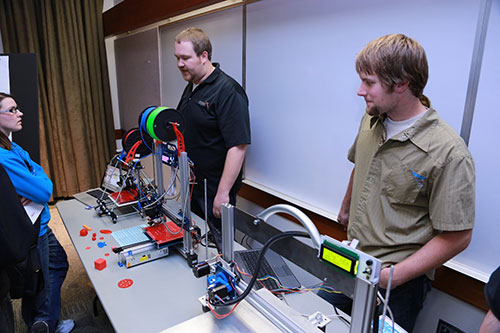
Jacob Anderson, Russell Grimshaw, Adam Hendrickson, Allen Humecky, Jeremy Leonard and Roger Greener*
Department of Engineering Technology and Construction Management
Abstract
Since first developed, 3D printers have historically been very expensive to purchase and run. In the last few years there have been major improvements to the field of 3D printers which has lowered the cost of purchasing one. This has also created a large variety of designs. We saw the emerging field of 3D printers as an opportunity to research current designs and build for ourselves a 3D printer. This 3D printer was not only affordable but was also expandable and incorporated the best of the designs currently out there and designs that we created ourselves.
Push Rod Suspension
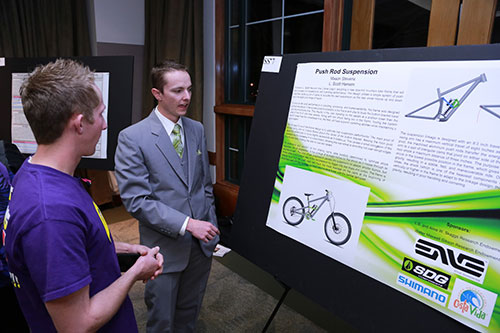
Mason Stevens and L Scott Hansen, Ph.D.*
Department of Integrated Engineering
Abstract
The industry of mountain biking is growing larger every year and with that growth demands new technology. Downhill mountain biking has been at the pinnacle of new innovations of material strength, lightweight components, frame geometry, and suspension performance.
Scott Hansen and I have begun designing a new downhill mountain bike frame that will have exceptional suspension and handling performance. The design utilizes a simple system of push rods that rotate a pair of cams to actuate the rear suspension as the rear wheel moves up and down within its eight inch range of travel. This linkage design allows the rear shock to be mounted in the lowest position possible inside the frame, resulting in a very low center of gravity and superior handling. Once the design is complete, we will begin construction of a prototype frame with chromoly tubing. After the completion of the frame, the bike will be built with lightweight aluminum and carbon fiber components that are donated or purchased. The end goal is to have a strong, lightweight, fully functional downhill mountain bike build to similar specification of those bikes being raced on the UCI Downhill World Cup race circuit.
Prevalence of Metabolic Syndrome Among Faculty, Staff, and Spouses at Southern Utah University
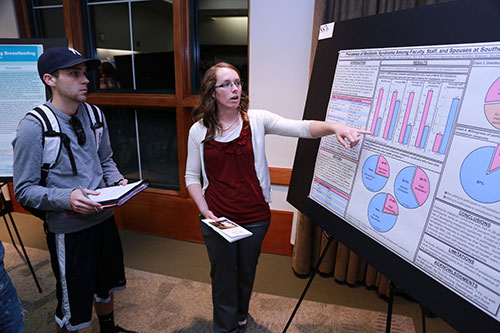
Kaitlin Torgersen, Erin Carter, Cynthia Wright, Ph.D.* and Nica Clark*
Department of Agriculture and Nutrition Science
Abstract
Metabolic syndrome describes a group of risk factors that increase risk for developing cardiovascular disease, type 2 diabetes, or stroke. These risk factors include elevated blood pressure, elevated fasting blood glucose, elevated waist circumference, and abnormal cholesterol levels. Metabolic syndrome occurs when three or more of these conditions are present together. According to the American Heart Association, 35% of American adults have metabolic syndrome (Association, 2011). This study evaluated Southern Utah University (SUU) faculty, staff, and spouses to assess presence of metabolic syndrome (presence of three risk factors) or at risk for developing metabolic syndrome (presence of two risk factors). Through a partnership with SUU’s Wellness Program, T-fit, 189 participants were assessed. More than 33 percent of participants have metabolic syndrome, while an additional 21.7 percent are at risk for developing metabolic syndrome, as evidenced by presence of two risk factors. Furthermore, a survey was administered to evaluate lifestyle factors that may contribute to the development of metabolic syndrome. SPSS21.0 was used to analyze data which revealed that there are many lifestyle factors that contribute to increased risk of developing metabolic syndrome.
Developing Recipes that Reduce Overall Fat Content in Baked Desserts with Common Foods as Fat Substitutes
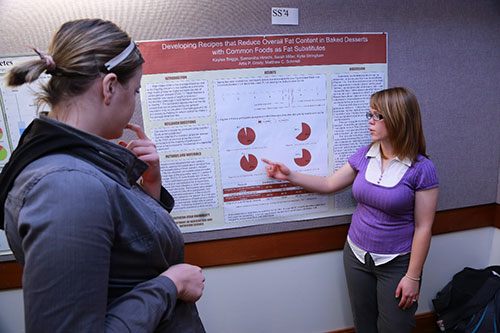
Kaylee Briggs, Samantha Hirschi, Sarah Miller, Kylie Stringham, Artis Grady, Ph.D.*, Matthew Schmidt, Ph.D.*
Department of Agriculture and Nutrition Science
Abstract
High intake of fat in the average American diet is an ongoing concern to the nutritional community. The successful development of low-fat recipes that can be produced by the general population may be valuable in the fight against CVD and obesity by reducing overall dietary fat intake. Researchers experimented with various common ingredients (applesauce, yogurt, pureed legumes, etc.) used as fat substitutes to produce four low-fat dessert products from popular recipes. Fat content was reduced by 56-73% from the original recipes. Fifty-six volunteer participants, age range 18-31 years, 37 female and 19 male, sampled each dessert and completed a short evaluation of the products. On a 7-point scale (1 extremely disliked to 7 extremely liked) products were rated with a mean acceptance score of 4.83 (brownie), 5.20 (oatmeal cookie), 5.45 (spice cupcake) and 5.49 (chocolate chip cookie). After being told the products were lower in fat, the percent of participants still deeming the products acceptable was: chocolate chip cookie (96%), oatmeal cookie (93%), spice cupcake (75%), and brownie (64%). When queried as to common ingredients that could be substituted for fat in baking, participants’ knowledge was lacking. They correctly identified applesauce and yogurt as possibilities, but incorrectly suggested usage of sugar substitutes, milk, margarine, whole wheat flour, and brown sugar. Although this population was accepting of the lower fat food products tested, they may benefit from education of suitable fat substitutes and how to utilize them in recipes as one strategy to lower dietary fat intake.
Bone density of athletes versus non-athletes
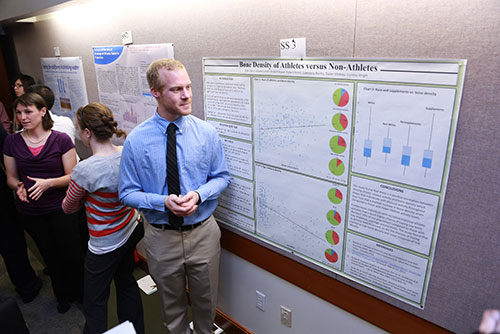
Erik Carter, Aubree Lyman, Robert Miguel, Ryland Morrill, Cashaana Renfro, Dallen Whitney, and Cynthia Wright, Ph.D.*
Department of Agriculture and NutritionScience
Abstract
Osteoporosis is a common disease that reveals itself as fractures occurring at multiple skeletal sites. This most often occurs at the spine, hip, or wrist, and causing significant injury and mortality. It was estimated that the prevalence of osteoporosis in the United States would increase from approximately 10 million cases to more than 14 million by 2012 (based on 2000 Census data). With a higher bone density earlier in life, the risk of developing osteoporosis decreases. Participation in physical activity such as organized athletics has often been associated with increased bone density.
This research project examined the question: Is there a difference in bone density of individuals based on their participation in sports?
This study found that there is a positive correlation between lifelong athletic related activity and bone density which shows that individuals with physical activity throughout their lives had a marked increase in bone density when compared to those with lower lifetime activity levels. Individuals with no history of participation in athletic activities had a much higher likelihood of having low bone density (~10% of our population) compared to those with low, moderate, and high activity levels. The study found that as activity level increased, so did the likelihood of having normal or high bone density.
Assessment of knowledge and behavior related to portion sizes
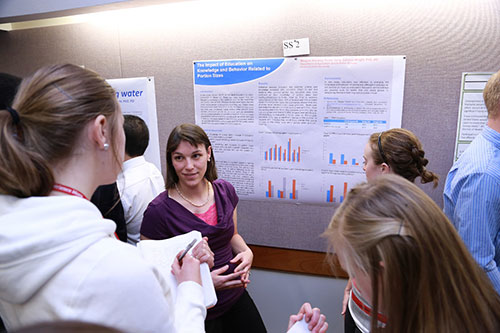
Portia Terry, Meagan Beesley, and Cynthia Wright, Ph.D.*
Department of Agriculture and Nutrition Science
Abstract
In the U.S. 35.7% of the adult population is either overweight or obese (cdc.gov). There are many factors that are thought to contribute to this epidemic such as the availability and portion size of food. This study assessed the effect of a nutrition education intervention on nutrition knowledge and eating behaviors. In this study, students enrolled in a general education nutrition course were asked to complete a pre/post survey related to eating behaviors and knowledge of portion sizes. After the pre-test the researchers presented education related to portion sizes to the students. Three weeks later, the post-test was administered to the students to assess changes. Additional participants were faculty, staff, and spouses who engaged in Southern Utah University’s health assessment were assessed. The staff/faculty and their spouses only completed the survey once and received no educational component. A total of 260 students and 190 staff/faculty/spouses completed the survey. Data was analyzed using Statistical Package for the Social Sciences, version 21. Paired t-tests were conducted on the student pre- and post-tests and independent t-tests were used to compare the students’ responses to the staff/faculty/spouses’ responses. Results are pending.
Testing For Coliforms In Drinking Water
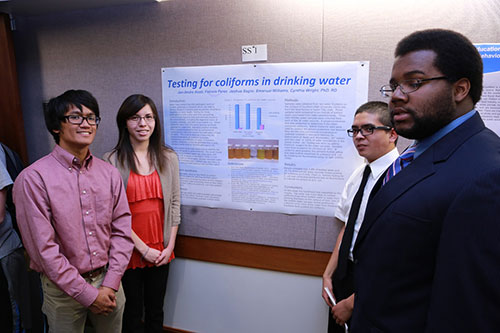
Fabiola Perez, Joshua Sagisi, Emanuel Williams, Jan-Andro Acob, and Cindy Wright, Ph.D.*
Department of Agriculture and NutritionScience
Abstract
Indicating the presence of Coliforms in each water sample will test the quality of bottled water and tap water. Coliforms are indicator organisms that come from the same sources of bacteria and will determine whether a number of pathogens will be present. Other microbial organisms are recommended to not monitor other dangerous pathogens because of their differentiated locations. (Byamukama and Kansiime et.al., 1999). E. coli can survive in drinking water between four to twelve weeks depending on the environmental conditions (Rice, Karlin, Allen, 2012). Ten different brands of bottled water will be used to test for coliforms as well as tap water from ten different households. Each brand of bottled water and household tap water will have three replicates of water samples. A good amount of water samples will each be placed one batch at a time in an incubator to analyze and promote the growth of bacteria. This will determine the purity of each sample. The samples will be taken to a dark room where a U.V. light will be utilized to illuminate the samples to detect the presence of E. coli. (Rice, Karlin, Allen, 2012).
Geologic Mapping Of Fracture Density And Mineralization In The San Francisco Range, Southwestern Utah
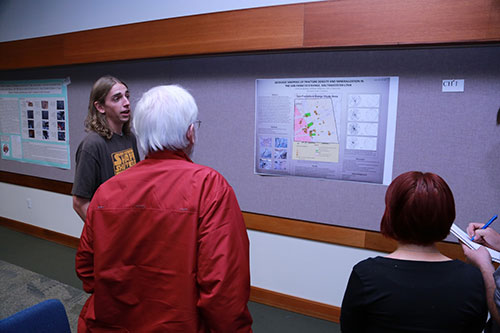
Chad Gardner, Jefferson Chipman, and John S. MacLean, Ph.D.*
Department of Physical Science
Abstract
The San Francisco Range in southwestern Utah has been mined heavily over the last several decades. Mining has been concentrated in Tertiary quartz monzonite intrusions into Paleozoic limestones. Significant resources occur along two major faults containing rich hydrothermal porphyry deposits, but the intersection of these faults has yet to be documented in detail due to poor outcrop exposure. In a partnership with a local mining company, undergraduates from Southern Utah University have begun preliminary mapping to locate and describe this fault intersection before underground exploration can begin. We used a Triton Juno GPS device to record the locations of exposed fractures, and we measured their fracture densities and orientations with a scale and Brunton compass. Results from rose diagrams, stereonets, and mapping show the existence of the intersection within the study area. Fracture density increases with proximity to the intersection, especially along one of the fracture orientations, and local mineralization along the faults is common. We recommend further exploration in the form of core drilling at the mineralized fault intersection to determine the viability of economic mining.
Hydrothermal Mineralization Of The Jurassic Navajo Sandstone In The Footwall Of The Blue Mountain Thrust Fault, Southwestern Utah
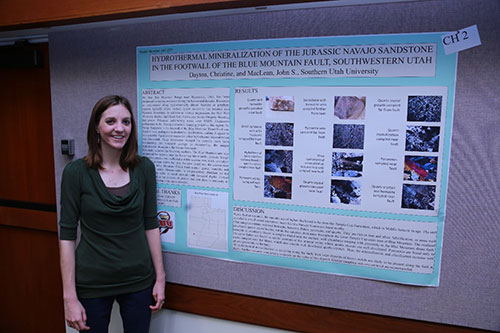
Christine Dayton and John S. MacLean, Ph.D.*
Department of Physical Science
Abstract
The Wah Wah Mountain Range near Minersville, Utah, has been prospected for mining resources during the last several decades. Resources are concentrated along hydrothermally altered fractures as porphyry deposits, typically where Tertiary quartz monzonite has intruded into Paleozoic limestones. In addition to Tertiary magmatism, the Wah Wah Mountains display significant Late Cretaceous Sevier Orogeny thrusting that placed Paleozoic sedimentary rocks over Middle Cretaceous sedimentary rocks. During a structural mapping project in this region, the Navajo Sandstone in the footwall of the Blue Mountain Thrust Fault was found to have undergone hydrothermal silicification, making it appear to be a quartzite. Upon closer inspection, other hydrothermal mineralization was discovered. These discoveries changed the research focus from documenting the structural geology to documenting the unique hydrothermal alteration in the Navajo Sandstone.
This study included the following methods. The Blue Mountain area was prospected for deposits near the Sevier-age thrust faults. Jurassic Navajo Sandstone samples were collected and thin sections were made to analyze the metal content within the rock. Samples found near the eastern-most edge of the Blue Mountain Thrust Fault contain quartz, hematite, and other minor metals. Mineralization is not particularly abundant, but the vein could be richer in metal deposits with increased depths. Further analysis, such as an analysis of gravity and core data, is necessary to determine the value of the mineralization.
Interpreting Sedimentary Facts and Facies Associations From A 1500-Ft long, Behind Outcrop Core Through Upper Cretaceous Strata In Se Utah
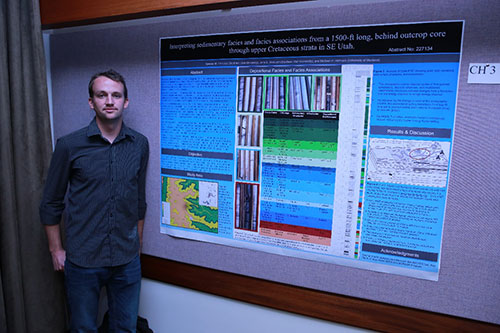
Spencer Francisco, John S. MacLean, Ph.D.*, and Michael Hofmann, Ph.D.*
Department of Physical Science
Abstract
The Book Cliffs in SE Utah have been a playground for many generations of geologists interested in clastic sedimentary rocks. Many of the exposures have been studied extensively because they offer good analogs for a range of nearshore, coastal, and terrestrial reservoirs in the subsurface. Most outcrops, however, only provide a 2D view and fail to fully characterize stratigraphic architectures and facies heterogeneity. In this study we present data from a new, behind outcrop core through the upper Cretaceous Price Canyon, Castlegate, and Blackhawk Formations. This study is part of a collaboration between Southern Utah University and the University of Montana that focuses on characterizing the 3D subsurface architecture and facies heterogeneity of these formations from a series of cores. The core described here contains a wealth of sedimentary facies associated with coastal and nearshore settings. Packages correlative to rocks of the Blackhawk Fm contain prominent packages of white, fine-grained, laminated and cross bedded sandstones, with thin mud partings, separated by packages of contorted and laminated gray to black mudstone, gray siltstone and by coal seams.
We interpret these packages to represent a transition from a coastal/delta plane environment dominated by fluvial processes to a fully fluvial environment during Castlegate time. Sandbody thickness (channel dimensions) change through time, and amalgamated, multi-story channels are more frequent in the Castlegate interval. Research will continue, beginning with a systematic analysis of the remaining cores through a series of undergraduate projects focusing on facies analysis and three dimensional facies models.
Martian Plate Motions In The Vicinity Of Vales Marineris And Tharsis Rise
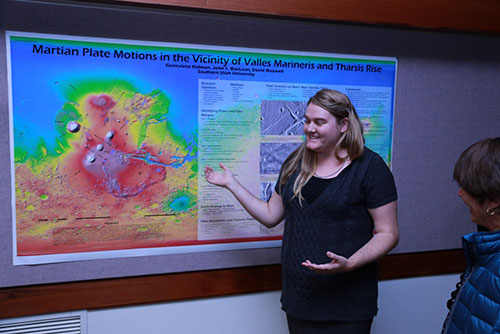
Genevieve Kidman, John S. MacLean, Ph.D.*, and Dave Maxwell*
Department of Physical Science
Abstract
Previous researchers have proposed a two-plate tectonic regime on Mars based on left-lateral transform displacement along Valles Marineris. Using technologies such as Thermal Emission Imaging System (THEMIS) satellite imagery, High Resolution Imaging Science Experiment (HiRISE) satellite imagery, digital elevation models, and interactive software (e.g. Google Mars), we have identified additional large-scale surface features in the vicinity of Valles Marineris and Tharsis Rise. Despite the much slower rates of tectonism on Mars, we can compare Martian lineations, folds, and conjugate joints to similar structures on Earth to interpret potential plate boundaries. For example, a northeast-trending set of lineations with significant left-lateral strike-slip displacement and conjugate jointing located to the northeast of Tharsis Rise could accommodate transform motion between two plates. Our observations allow the designation of at least two additional potential plate margins in the region. We propose a tectonic model showing relative motions along plate boundaries that shows a multiple-plate system on Mars.
Potential Excess Precipitation (Pep) Value, An Additional Description For Arid/Semiarid Climates
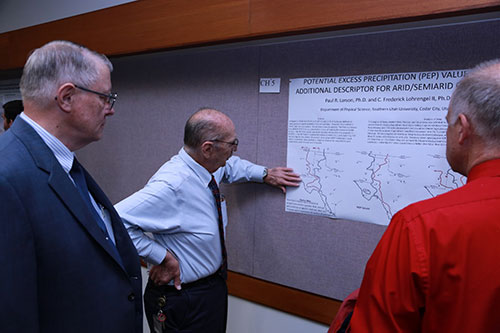
Paul R. Larson, Ph.D. and C. Frederick Lohrengel, Ph.D.
Department of Physical Science
Abstract
In Köppen’s Climate Classification, Arid/Semiarid, or B, climates are defined as having greater evapotranspiration than precipitation. However, he provided no formal calculation procedure. We propose a new designation, the Potential Excess Precipitation (PEP) Value as a convenient means of locating the semiarid-humid frontier. The PEP Value equals actual precipitation minus potential evapotranspiration (POTET). If the PEP Value is positive the station climate is an A, C, or D, but if the PEP Value is negative the station climate is B. Application of PEP Values gives each station a numerical value, positive or negative, that can be mapped, the zero isoline defines the semiarid-humid frontier.
A Paleoenvironmental Analysis of a Plant Quarry in the Kaiparowits Formation of the Grand Staircase Escalante National Monument, Utah
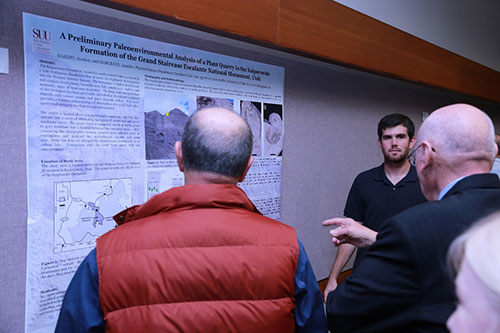
Gordon Haight and Jennifer Hargrave, Ph.D.*
Department of Physical Science
Abstract
The Kaiparowits Formation, located in south central Utah, is a record of a Late Cretaceous floodplain that drained the highlands of Laramidia into the Western Interior Seaway. The formation is highly fossiliferous and contains fossil plants, invertebrates, fish, amphibians, reptiles, and mammals, many of them new to science. The large-scale interpretation of this formation has been previously described as fluvial and floodplain deposits with various swamp and pond deposits within. This study provides a detailed sedimentological description of a small fossil plant quarry and interprets the depositional environment.
The quarry is located above a conglomeratic sandstone unit that fines upward into a series of alternating fine-grained sandstones and green mudstone layers. The quarry itself is composed mostly of friable green to grey mudstone that is located between two sandstone units. After measuring the stratigraphic section, samples were collected every 10 centimeters and analyzed for mineralogical content and grain size. From this data, we interpret the depositional environment as an oxbow lake. Comparison with the fossil flora agrees with this interpretation.
Teaching fish biology through a STEAM approach
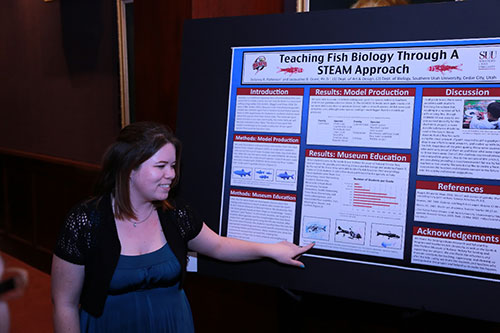
Delaney Patterson and Dr. Jaqualine Grant, Ph.D.*
Departments of Biology and Education
Abstract
Most children know what a fish is and where it lives, but few know how its shape or morphology provides us with clues about its habitat. We created silicon rubber fish models to teach K-8 children about fish morphology, habitat specialization, and the art of gyotaku. The Japanese art of fish printing is known as gyotaku and has been practiced for approximately 200 years. We categorized fish into three non-technical categories: “rover,” “hider,” and “spinner.” During 20 minute sessions with students, we introduced to the morphologies, demonstrated the gyotaku method, then allowed them to choose a rubber fish model and create a print. Students were then asked to categorize their fish into one of the three categories and speak about the type of habitat in which the fish might live. The activity was messy, but seemed to be a successful learning technique.
Effects of habitat on the distribution of forensically important insects in Utah
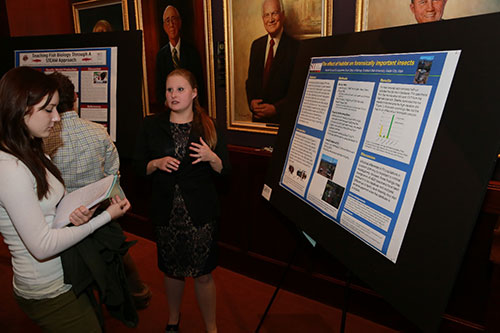
Moriah Guy and Dr. Jaqualine Grant, Ph.D.*
Department of Biology
Abstract
Our research project was designed to collect information about forensically important insects (FII) and the affect location has on the population density of local FII. FII are insects that use remains as a resource for colonization, reproduction, and nutrient absorption. Studies, like our project, are used to gather information about the types of FII in a particular geographical location and a particular succession rate of FII. Information learned through this type of research can be used in the field by forensic entomologists to help determine important information about a set of remains. FII can provide information pertaining to time and location of death as well as whether a body has been moved. Such information is not only useful in human related cases but also in wildlife poaching cases. To make sure our methods met scientific standards in forensic entomology, our project was designed using peer reviewed, published papers in the field of Forensic entomology.
A mobile device “app” for forensically important insect identification
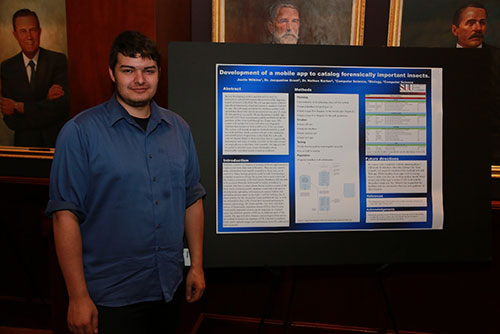
Justin Wilkins, Jacqualine Grant, Ph.D.* and Nathan Barker, Ph.D.
Departments of Biology and Computer Science & Information Systems
Abstract
I am developing a system that will organize and store information about forensically important insects found in the field. This system will include an app for Android, iOS and a web application. Users will be able to sign in and access this information to research insects from southern Utah. So anybody that is interested in forensically important insects and where they are found would find this app useful. The mobile apps will allow users to catalog their own data pertaining to insects on their app. The insect information stored publicly in the app will be based on insects collected in southern Utah by Dr. Jacqualine Grant and SUU undergraduate researcher, Moriah Guy, as well as data from the primary literature.
Effects of seasonal changes on geographic distribution and species diversity of bats
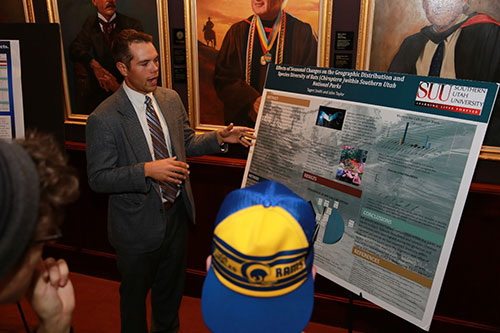
Tagert Smith and John Taylor, Ph.D.*
Department of Biology
Abstract
It has been observed that temperate bat species exhibit seasonal movement because of increased energy demands during the summer gestation periods and decreased demands during cooler months when bats enter into torpor. Although the seasonal distribution of bats varies, the seasonal distribution of bats within Southern Utah has not been heavily studied. We studied the seasonal differences in species diversity and geographical distribution of bats by monitoring monthly changes in populations. If the diversity and geographical distribution of bats is related to energy demands, then changes therein will correlate with seasonal temperatures. Samples were collected from Bryce Canyon National Park, Zion National Park, and Cedar Breaks National Monument in locations that are common bat flyways/waterways. Sonobat technology was used to conduct acoustical surveys near ideal bat foraging areas in order to determine the presence and composition of bat species. Mist-netting events were coupled with acoustical surveys in order to capture and verify the presence of bats that are less easily observed through acoustics. Although our results are in the process of analysis, they show promise in providing baseline data for species. By understanding the distribution and species diversity of bats, parks can determine conservation plans for bat species management.
Leech Population Genetics in Southern Utah
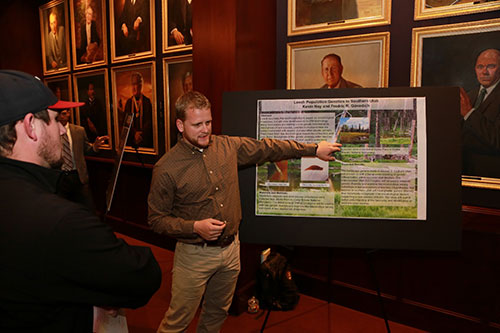
Kevin Nay and Dr. Godedich, Ph.D.*
Department of Biology
Abstract
Leech taxonomy has traditionally been based on morphological characters, but with new developments in DNA technology many taxonomists are starting to use genetic information in descriptions of new species. Leeches in southern Utah are poorly inventoried with respect to many other aquatic animals. There have been few morphological inventories of leeches and even fewer descriptions of the genetic diversity within leeches. Landscape genetics is a powerful tool used to understand geographic patterns of genetic diversity. Southern Utah has many naturally isolated bodies of water due to the climate and the dramatic changes in elevation in this part of the country. The landscape genetic study of leeches in southern Utah will provide us with a better understanding of genetic differentiation within southern Utah leeches. The mitochondrial DNA (CO I region) will be used to estimate genetic diversity and examine the relationships among individuals in two populations of leeches. I hypothesize that leeches in southern Utah will have greater genetic diversity then historically recognized from morphological studies suggesting a new species of leech. The study will lead to better understanding of the taxonomy and identification of southern Utah leeches.
Analysis of ok2951, a mutation found in F56D2.6, a putative homologue of the yeast PRP43 protein
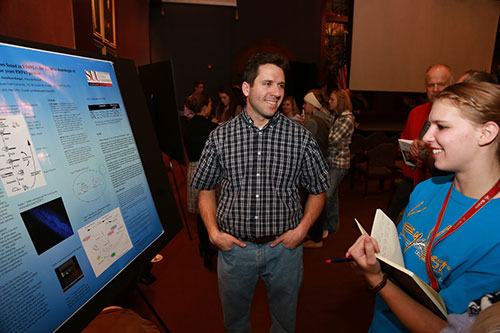
Jonathan Karpel , Ph.D. and Miranda Roland
Department of Biology
Abstract
F56D2.6 is a putative helicase of the “DEAH box” family that is a homologue of the yeast spliceosomal protein, Prp43p. The Prp43p protein is required for the release of the lariat intron from the spliceosome and also plays a significant role in ribosome biogenesis. RNAi directed toward the F56D2.6 gene in C. elegans showed no overt phenotype, but a balanced strain that produces homozygous F56D2.6 (ok2951) knockout worms shows a sterile phenotype. DAPI staining of these homozygous mutants reveals that their germline only have undifferentiated germ cells and no sperm was observed. We are especially interested in potential splicing errors involving the sex determination genes or miRNA required for proper regulation of these sex-determination pathway genes. To date, we have not found any splicing errors, but using miRNA analysis and qRT-PCR we have found a marked decrease in miRNA 35-41 expression in ok2951 mutant worms. Potential implications of this data are discussed.
Admissions Departments’ Opinions on the Ethics of Genetic Screening for Cognitive Ability
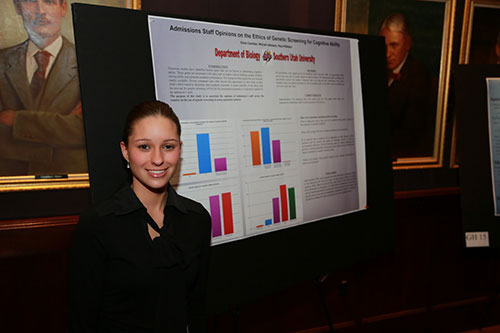
Chris Cormier, McCall Johnson and Paul Pillitteri, Ph.D.*
Department of Biology
Abstract
Numerous studies have identified human genes that can be factors in determining cognitive ability. These genes are associated with traits such as higher critical thinking, greater problem solving skills, and increased academic performance. The testing for these genes has also become readily available. Private companies now offer anyone the opportunity to have their or their child’s DNA tested to determine their academic potential. It seems possible, if not likely, that the next use for genetic screening will be for the assessment/acceptance of potential students by the admission’s departments of institutions of higher education. The purpose of this study is to ascertain the opinions of admissions staff across the country on the use of genetic screening to assess potential students. An anonymous online survey was sent out via email request to approximately 5,000 admissions staff at colleges and universities across the country. Response data was analyzed and correlations were drawn between views on genetic screening as well as academic and social factors such as, gender, age, test score, and class rank. Many of the admissions staff were not in favor of using genetic testing to evaluate cognitive ability. This data may initiate discussion on the subject and possibly serve as the basis for establishing regulations for genetic screening of prospective students if it were to indeed become more common practice.
Cloning and Expression of β-caryophyllene synthase from Ericameria linearifolia
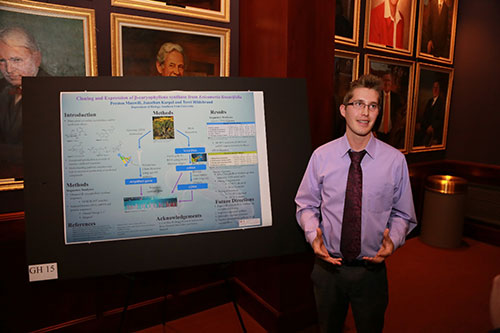
Preston Manwill, Jonathan Karpel, Ph.D.* and Terri Hildebrand, Ph.D.*
Department of Biology
Abstract
Plants produce compounds, secondary metabolites, which can be harnessed for medicinal uses. Caryophyllene, a secondary metabolite produced by a variety of higher plants, has shown promise as an analgesic and anti-inflammatory. Caryophyllene synthase is the final enzyme in the biosynthetic pathway that produces caryophyllene. The gene and enzyme responsible for caryophyllene production have been observed in crop plants and model organisms, but few studies have investigated caryophyllene production in indigenous plants. We investigated the production of caryophyllene in Ericameria linearifolia (Narrowleaf goldenbush) because it is a shrub native to southwest North America. The first portion of this research examined sequence similarities between caryophyllene synthase gene orthologs in E. linearifolia and other plant genera. Genomic DNA was isolated from E. linearifolia leaves collected from plants growing in southern Utah. Literature reviews and database inquiries have provided DNA sequences for similar synthases, from which primers will be designed to copy and sequence the E. linearifolia caryophyllene synthase gene, confirming the orthologs presence. Following confirmation of the gene, mRNA will be extracted from leaf material and oligo(dT) primers used to synthesize cDNA. Subsequent cDNA amplification and cloning of products into a vector will allow for transformation into a protein-producing bacterium. These final steps make the downstream procedures of protein production, structure determination, and functional characterization of the protein possible. Comparison with enzymes that produce similar organic compounds may result as well, and would provide insight that could improve the biosynthesis of medicinal compounds.
Effects of co-occurring environmental stressors on larval amphibians
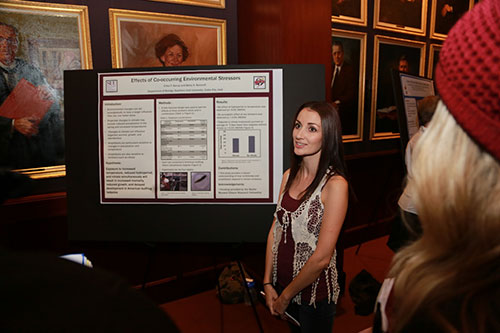
E Seirup and B.A. Bancroft, Ph.D.*
Department of Biology
Abstract
Environmental factors such as temperature and precipitation can influence survival, growth and reproduction of individual organisms. Changes in climate patterns, particularly temperature and precipitation, are projected to have large negative impacts on amphibian populations worldwide. Amphibians are of particular conservation concern, as amphibian populations are declining more rapidly than either birds or mammals. The study tested the effects of relevant environmental factors (temperature, precipitation, and nitrogen-based fertilizers) on American bullfrog (Lithobates catesbeiana) tadpoles. These factors were tested alone and in combination and were replicated six times, for a total of 48 experimental units. The information obtained in the study will help illuminate the response of an invasive species to environmental change.
Survey of nitrate levels and sedimentation rate in Southern Utah water bodies
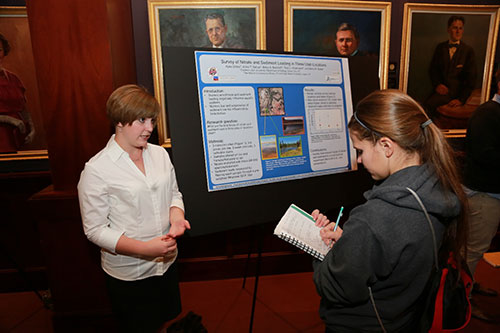
Kylie Gillins, Erika Seirup, Terri J. Hildebrand, Ph.D.*, Barry Baker, Ph.D., and Betsy A. Bancroft, Ph.D.*
Department of Biology
Abstract
Freshwater habitats comprise some of the most altered ecosystems on Earth, primarily due to anthropogenic disturbances in hydrology and nutrient cycling. Many freshwater systems in North America are limited by nitrogen and phosphorus, and their addition from anthropogenic sources (from agricultural and residential runoff or atmospheric deposition from air pollution) can cause eutrophication. Changes in abiotic and biotic factors due to eutrophication often result in reduced water quality and ecosystem services such as water filtration. Projected shifts in regional precipitation and temperature as a component of global climate change will further alter the functioning of freshwater ecosystems. Alterations in precipitation, coupled with shifts in land-use, are projected to increase sediment loading in freshwater systems. Sediment loading in freshwater ecosystems can result in changes to community structure, biomass, and primary productivity. In addition, sedimentation can reduce net photosynthesis rates by smothering periphyton, the photosynthetic protists that exist in the biofilm that forms on surfaces. We measured nitrate levels and sedimentation rate in 9 water bodies in Southern Utah. We surveyed ponds near Cedar City, UT, ponds on the Markagunt Plateau, UT, and ponds near Canyonlands National Park, UT. Both nitrate levels and sedimentation rates were highly variable. These data were used to inform treatment levels for an experiment studying the effects of tadpoles on primary production.
Population biology and genetics of invasive turtles in the Virgin River Basin
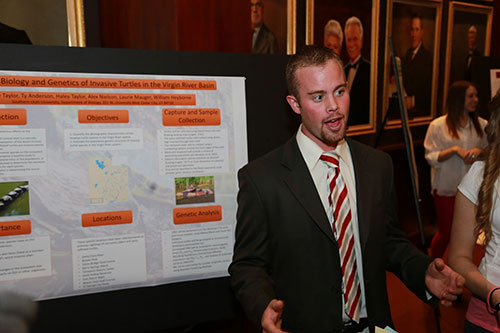
Riley Taylor, Ty Anderson, Bill Heyborne, Ph.D.*, Laurie A. Mauger, Ph.D.*
Department of Biology
Abstract
Invasive species cause extensive ecological damage and are considered major threats to the biodiversity of ecosystems. The mode that invasive species succeed ranges from out-competing the native species to utilizing changing abiotic factors. The red-eared slider (Tracheyms scripta) and the smooth soft-shell (Apalone spinifera) have been marked as invasive exotics throughout many areas of the world. They have the potential to cause deleterious effects on native species. There are no chelonian species native to southern Utah, with the exception of the endangered desert tortoise. However, both T. scripta and A. spinifera have been noted in abundance in the Virgin River drainage system. We propose to quantify the effects these species have on this system and the endangered fish species found therein. We have two main objectives for this proposal. The first is to quantify the demographic characteristics of these invasive turtle species in the Virgin River System. Secondly, we will estimate the population genetic structure of these invasive turtles to determine effective population sizes and attempt to identify the source populations. Turtles will be trapped in several areas throughout the drainage system to estimate population size, analyze stomach contents, identify nesting areas and collect genetic material. We will extract DNA and characterize several microsatellite loci in the invasive populations. This information will be used to assess the impact that these invasive species have on the Virgin River ecosystem.
Population genetics of tiger salamanders (Ambystoma tigrinum) in southern Utah
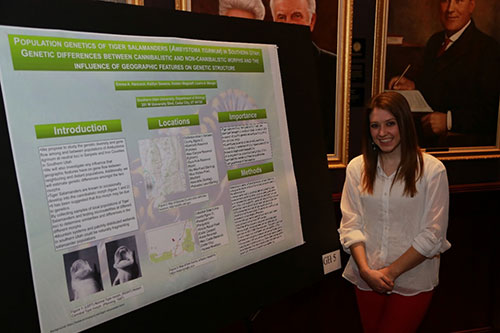
E. Alex Hancock, Kaitlin Gowans, Holden Wagstaff, Laurie A. Mauger, Ph.D.*
Department of Biology
Abstract
Isolated populations have been hypothesized to undergo independent evolution. As habitat fragmentation increases, it is becoming increasingly important to preserve the remaining biodiversity. Quantifying diversity at the genetic level is a crucial step in understanding complex interactions between fragmented populations. Tiger salamanders, Ambystoma tigrinum, are abundant throughout southern Utah, however little is known about the demographic characteristics and genetic diversity in this part of the species range. Mountain ranges, patchily distributed ponds, and increasing droughts could be naturally fragmenting populations of this species. Increasing nitrogen levels in Utah lakes has been identified as a potential threat to A. tigrinum populations. We propose to study the genetic diversity and gene flow among and between populations of A. tigrinum at neutral loci in Sanpete and Iron Counties in southern Utah. We will employ a landscape genetic approach to investigate any influence that geographic features have on gene flow between neighboring and distant populations. This study will provide important information on A. tigrinum in southern Utah. Understanding the genetic connections between naturally fragmented populations is becoming increasingly important with projected local and global environmental changes.
Population genetics of tent caterpillars, Malacosoma californicum pluvial, in southern Utah
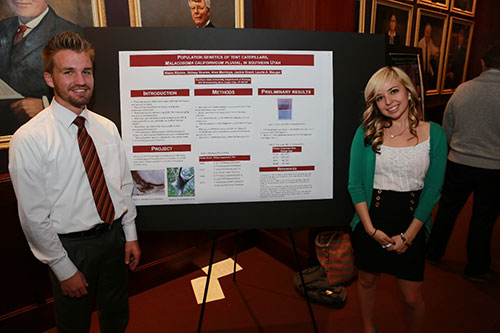
Blaire Ritchie, Alex Montoya, Sidney Vowles, Jackie Grant, Ph.D., and Laurie A. Mauger, Ph.D.*
Department of Biology
Abstract
Pest species are often associated with high ecological and economic costs. Genetic techniques have been poorly used in understanding pest species, despite their potential usefulness in pest management. The western tent caterpillar, Malacosoma californicum pluvial, is considered a pest in southern Utah. Nests are abundant throughout the area each spring on cottonwood and willow trees. We are conducting an ongoing population genetic study investigating gene flow and minimum number of genetic populations of tent caterpillars. Caterpillars were collected from several localities in and around Hurricane, UT from both host species. DNA will be amplified at ten microsatellite loci and analyzed for standard measures of genetic diversity, gene flow and number of populations. Understanding the genetic connections between populations of pests could enhance management practices and decrease the economic and ecological costs associated with the tent caterpillar.
Terrestrial Gastropods in the Pine Valley Mountains
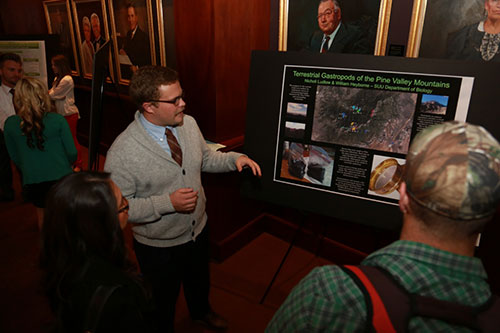
Nicholi Ludlow and Dr. William Heyborne, Ph.D.*
Department of Biology
Abstract
Identification and cataloging of species is important when measuring the overall health of ecosystems, classifying interactions between populations within communities and in conservation efforts. The purpose of the current study is to conduct an exploratory survey of terrestrial gastropods located in the Pine Valley and surrounding mountains. Gastropods are primary consumers and play a crucial role in ecosystems as prey for other organisms, but are imperiled as a group. To date, this is the first research conducted to identify which species of gastropods live in this region. Thus far nine separate soil collections, from locations within the survey area - selected for prime snail habitat, have been made. Subsequent sorting and classification of the shells has commenced. A sieve series is being used to sift away soil and leave behind the shells. The collected shells will then be identified using dichotomous keys. Final products will include a list of terrestrial gastropod species for use by personnel from Dixie National Forest, Utah Division of Wildlife Resources, and the malacological community.
The effect of anthropogenic nitrogen and sedimentation on primary producers: do tadpoles matter?
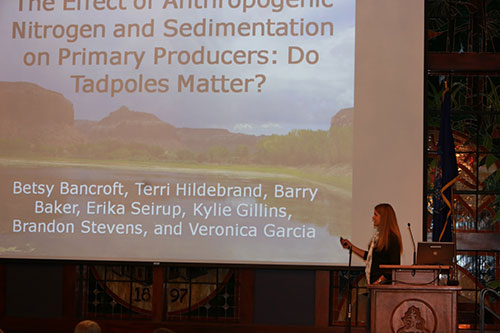
Betsy A. Bancroft, Ph.D.*, Terri Hildebrand, Ph.D.*, Barry Baker, Ph.D.*, Erika Seirup, Kylie Gillins, Brandon Stevens, and Veronica Garcia
Department of Biology
Abstract
Freshwater habitats comprise some of the most altered ecosystems on Earth, primarily due to anthropogenic changes in hydrology and nutrient cycling. Many freshwater systems in North America are limited by nitrogen and phosphorus, so the addition of these nutrients can cause harmful algal blooms. Along with nutrient addition, sediment loading due to dust storms and erosion can result in alterations to community structure, biomass, and primary productivity in freshwater systems. Several groups of animals have been shown to directly influence sediment accrual rate, including shrimp, fish, crayfish, and stoneflies. Larval amphibians (tadpoles) could also directly influence sediment accrual and nitrogen cycling. Sediment clearing and grazing by amphibians could affect growth of primary producers in three ways: 1) tadpoles could increase the amount of nitrogen suspended in the water column, increasing the growth of suspended primary producers (phytoplankton); 2) tadpoles can clear sediment from surfaces, thereby increasing light available for primary producers attached to surfaces (periphyton); 3) tadpole grazing on primary producers (phytoplankton and periphyton) could reduce biomass of these primary producers. We used a fully factorial experimental design to test the effects of tadpole grazing and sediment clearing on photosynthetic organisms. Understanding the connections among species and how those connections influence the response of functional groups in the community (i.e. primary producers) is increasingly important in the face of local and global environmental changes.
Growth in Baumslag-Solitar groups (asymptotics)
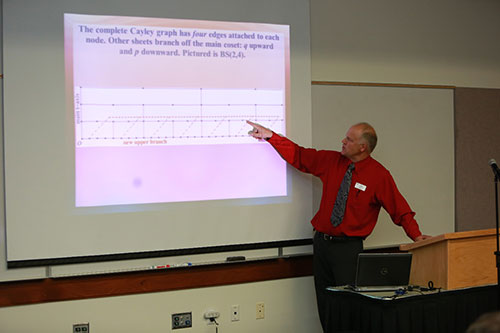
Eric Freden, Ph.D. and Jared Adams
Department of Mathematics
Abstract
Using the specific example of BS(2, 4) we estimate the asymptotics of the spherical growth series. The techniques utilize standard tools from number theory and imply that the actual computation of growth series terms may be an intractable problem.
Using Popular Culture as a Creative Teaching Strategy to Promote Critical Thinking
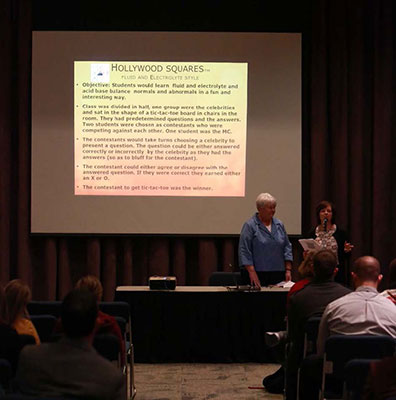
Rebecca Rasmusson APRN-BC, MSN, Shelley Sanderson APRN-BC, MSN
Department of Nursing
Abstract
As nurse educators we need to strive to engage students in the learning process. This can be done in a variety of ways. The National League of Nursing (NLN) excellence in nursing education model states, curricula must be interactive an innovative. To be innovative we must make efforts to meet the diverse learning needs of the students. Although the classroom will reflect a multigenerational population, the average age of new nursing graduates has remained about the same, around 26.2 years age. The traditional learning environment is not optimal for the present generation of nursing students, defined as millennial learners. They are more social, prefer to work in teams and participate in activities that promote social interaction. The desire for interactivity and the social nature of the millennial learner encourages implementation of creative teaching strategies in the area of games and group work. We can accommodate this new generation of learner by creating learning activities that entice them to learn, utilize things they are familiar with and embrace their perception of the world.
Our oral presentation will demonstrate how popular culture can be used in the classroom as a creative teaching strategy to create an interactive learning environment.
A Study of Bonneville Cutthroat Population and Habitat for Potential Transplant
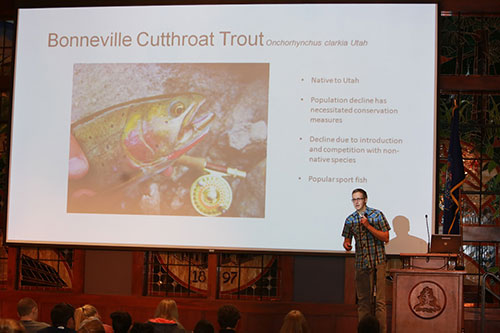
Jens Swensen; Paul Spruell, Ph.D.*; Mike Hadley*, Utah DWR; Mike Golden*, USFS
Department of Biology
Abstract
In this study, the trout populations and habitats of two southern Utah streams will be analyzed and compared. The native Bonneville cutthroat trout from Little Creek and the non-native rainbow trout from Pinto Creek will be compared through population estimates by electro-fishing. Habitat analysis will also take place through quantitative observation and comparison to ideal habitat conditions within both streams. All data will be gathered and compared with the purpose of determining whether the Bonneville cutthroat trout in Little Creek have been successfully established and whether the habitat of Pinto Creek will facilitate the cutthroats’ successful introduction. The Bonneville cutthroat will then be considered to replace the non-native rainbow trout population found in Pinto Creek. This species replacement would remove the rainbow trout and increase the population of the Bonneville cutthroat in its native range. This study will also compare populations of Utah’s native speckled dace which are found in both streams.
Cannulated Cow
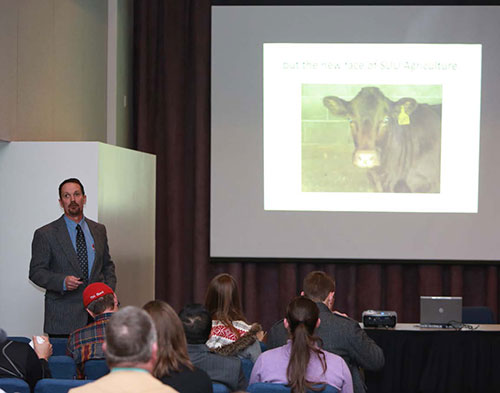
Randall Violett, Ph.D.
Department of Agriculture and Nutrition Science
Abstract
Having access to cannulated animals will allow the faculty to develop hands-on laboratory exercises as well as seek research projects. Being able to examine what the animal eats while on the rangeland can help develop recommended seed mixes and plant species selection. Being able to place different feeds into a functioning rumen will allow the researcher to determine digestibility of that feed. Many Universities use cannulated animals and it is a very common procedure for a veterinarian to perform. The animal will live a full and productive life; in fact many of them become ambassadors for animal and range science programs and are used at elementary school programs as well as general public education and extension programs. This presentation will inform the audience of the procedure and invite faculty and students of COSE to collaborate on projects that may involve a cannulated cow.
The Effects of Color on Crayfish Hunting Behaviors
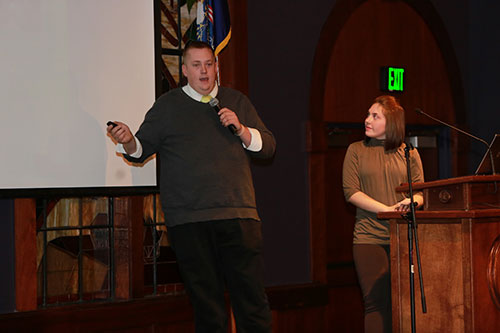
Kasey D. Shakespear, Ruth J. Workman, and Elizabeth Bancroft, PhD*
Department of Biology
Abstract
Color has shown apparent impacts on animal behaviors. We are interested in studying behavioral cues in Orconectes virilis or northern crayfish. Research has shown that crayfish have the necessary neuron receptors in their eyes to perceive color. One specific area of interest concerning the effect of color on crayfish behavior is the impact it has on their hunting behavior. We believe that brighter colors cue genetically programmed hunting responses in northern crayfish. The Northern crayfish is native to lakes and streams all over the Western United States including Utah. We are going to catch northern crayfish in the Red Cliff River in Washington Co. Utah. These crayfish will be placed in tubs with different colors of chicken cubes, to test which of the colors they target. We believe they will target the brightest colored chicken first. This research would lend an insight into how the presence of crayfish can impact an ecosystem, based on their role as a predator.
Black Holes, Random Walks, Gaussian Statistics, and how the heck these could all be related
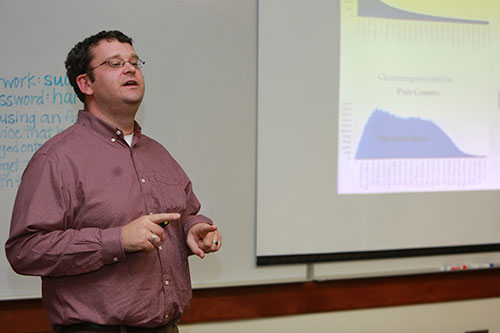
James R. Chisholm, Ph.D.
Department of Physical Science
Abstract
In this talk I will describe current and past work done examining the theoretical production and statistics of primordial black holes in our early universe. The idea that there could be black holes created in the early stages of our universe’s evolution goes back more than 30 years; observational cosmology is at a point where high resolution observations are able to put stringent limits on their production. It is important, however, to have well-grounded theoretical models of their production and subsequent time evolution, and that is the research I am working on. In particular, assuming that these black holes form at the peaks of a Gaussian random field, what are the large-scale statistics of these objects? I will also describe work done with a former SUU student (Brandon Wiggins) attempting to model these statistics by implementing a random walk algorithm, as well as future directions of research and possible undergraduate student project ideas.
The Role of Organic Ligands in Molecule-Based Magnets
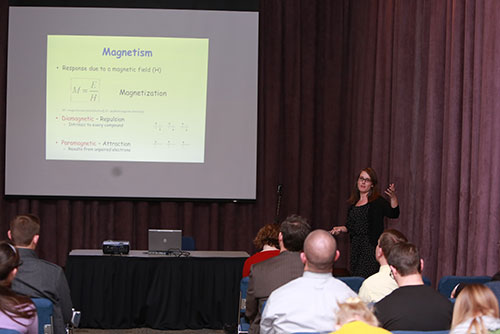
Amber McConnell, Ph.D.
Department of Physical Science
Abstract
The design and investigation of so-called “smart” or tunable materials that have potential technological application is an expanding facet of current research. In particular, the study of magnetism and magnetic materials has led to discoveries that have developed into exciting fields of study such as: molecule-based magnets (MBM), spin-crossover, spintronics, photomagnetism, single-molecule magnets, and nanomagnetism, to name a few. The area of interest that will be presented is molecule-based magnetism and specifically the many roles that organic ligands perform in these materials. Traditionally magnets are atom-based and comprise of metal and/or metal oxides and the bulk magnetic properties of these materials arise from the unpaired electrons residing on the metal centers. However, the inclusion of organic ligands into these materials can change the bulk magnetic properties dramatically. The investigation of the function-structure-property roles of these ligands is essential in order to gain a more enhanced understanding of the mechanism of magnetism and for the future design of magnetic material.
Minimum number of breeding adults in American crocodile, Crocodylus acutus, populations in Santa Rosa, Las Baulas, and Palo Verde National Parks, Costa Rica
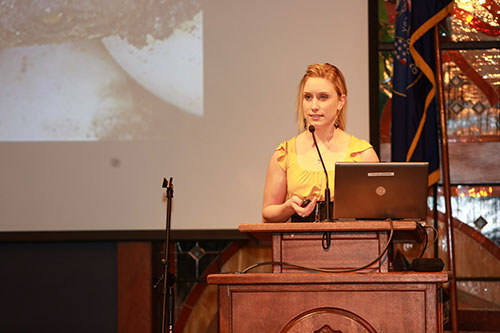
Kiristin Ranson, Elizabeth Velez, James R. Spotila, Laurie A. Mauger, Ph.D.*
Department of Biology
Abstract
The American crocodile, Crocodylus acutus, is widely distributed in the American neotropics. It is endangered throughout most of its range and is listed as vulnerable by the International Union for the Conservation of Natural Fauna and Flora (IUCN) and on Appendix I of the Convention for the International Trade in Endangered Species of Wild Flora and Fauna (CITES). Despite this listing, there are few published reports on the reproductive biology throughout the species range. Previous work has indicated that multiple paternity exists in C. acutus, but this phenomenon has been studied in few wild populations. Genetics samples were collected from hatchlings in Santa Rosa, Las Baulas, and Palo Verde National Parks, Costa Rica. The mother crocodile could not be identified. Crocodile encounter rates range from1.3 crocodiles/km (Santa Rosa) to 4.1 crocodiles/km (Palo Verde). Preliminary results indicate that hatchlings from the smaller populations were more related, suggesting fewer breeding adults in these areas. We used a genetic analysis to estimate the minimum number of breeding adults (males and females) in Santa Rosa, Las Baulas, and Palo Verde National Parks. This study will provide important information on reproductive biology in naturally fragmented populations and could enhance management practices of crocodiles worldwide.
Researching Solutions to Construction challenges in Tanzania, Africa
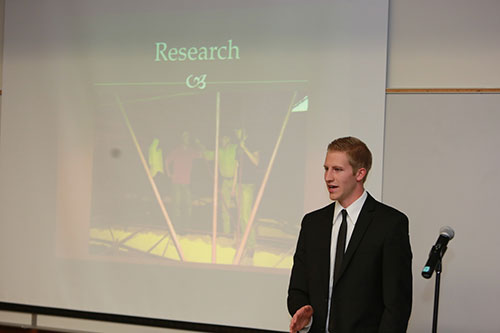
Jameson Porter, Taylor Schone, and Boyd Fife*
Department of Engineering Technology and Construction Management
Abstract
Water Mitigation Research for the Nashera Hotel in Morogoro, Tanzania
The Nashera Hotel was constructed in 2010 in Morogoro, Tanzania and was experiencing water damage in several areas. The roof was not properly constructed allowing rain water to penetrate into the ceiling which damaged sheetrock and paint. The hotel was experiencing additional damage because individual room shower enclosures were not properly caulked and sealed to prevent water leakage.
Construction Managements students researched the most economical way to effectively divert rain water in the roof area and submitted the research to the Nashera Hotel Management. After review by the hotel management, approval was given for the implementation of the research conclusions.
The CM students also provided research on ways shower water could be controlled which was also approved for implementation. The students trained Nashera Hotel maintenance personnel on how to proceed with the follow through portion of the research. The follow up report from the hotel manager has indicated that the solutions implemented because of this research have been successful.
Formation of Lipid Vesicles from Supported-Lipid Bilayers Using a Single-Channel Microfluidic Device

Cameron Cooper, Mason Valentine and Christopher F. Monson, Ph.D.*
Department of Physical Science
Abstract
Cell membranes have a central importance in medicine and biology. This presentation will focus on a method that has been developed for repackaging regions of supported lipid bilayer into lipid vesicles, which mimic the properties of cell membranes in vitro. Supported lipid bilayers were formed on clean glass slides inside the channel of a microfluidic device with a single inlet and outlet for deionized water. Deionized water flow was subsequently used to peel lipids off of the glass slides and reform them into vesicles. The extent to which stripping occurred was proportional to the rate at which water flowed through the channel, and did not occur at all below a threshold flow rate.
Asthma and Omega-3 Fatty Acids
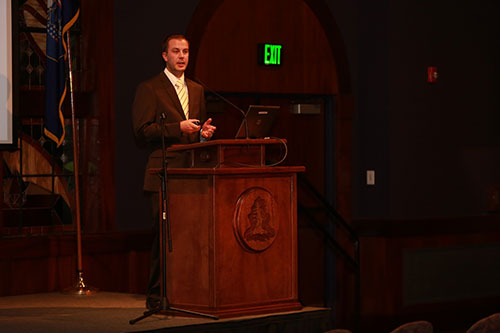
Matt Mogensen and Dr. Matthew Weeg , Ph.D.
Department of Biology
Abstract
The anti-inflammatory effects of omega-3 fatty acids (n3) and their possible role in the regulation of asthma are promising for those suffering from the disease. N3 have been linked to the reduction of eicosanoids, which are signaling molecules that regulate the inflammatory response. Inflammation in the respiratory system is one of the most widespread symptoms of asthma and therefore poses the most risk to asthmatic individuals. This two phase study will test the effectiveness of n3 in individuals with varying severities of asthma. In both stages of this study, a placebo or n3 in the form of a krill oil capsule containing the omega-3 fatty acids eicosapentaenoic acid (EPA) and docosahexaenoic acid (DHA) will be administered, lung volumes and capacities will be measured weekly, and the frequency/severity of asthma attacks will be recorded. Phase one of the study will test whether n3 reduces asthma symptoms with no activity modifications, while phase two will test whether n3 is effective in reducing asthma symptoms associated with exercise. If n3 is effective, we expect to see an increase in lung volume and a decrease in the frequency and severity of asthma attacks in individuals. These results would suggest that n3 could be an effective and simple treatment that, when taken daily, could reduce the frequency/severity of asthma attacks and help improve quality of life for asthma sufferers.
Affordable Comfort in the Home
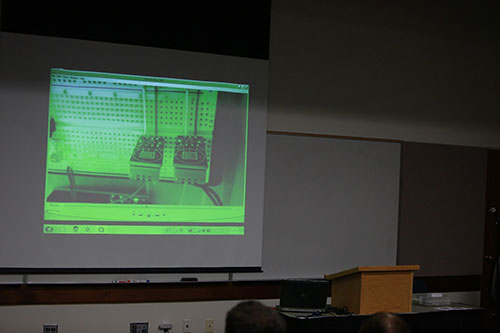
Arlo Fawson, David Howard, Maicah Anderson and Thad Morton, Ph.D.*
Department of Integrated Engineering
Abstract
Air Conditioning units (AC) and Swamp Coolers are two common methods of cooling used in homes today. In this area, swamp coolers are typically more popular because of the affordability factor. Swamp coolers cost close to 75% less than the average AC unit. However, swamp coolers promote mold growth and cause an uncomfortable humid environment.
We have created a dual-action cooling unit called the Climate Control Unit (CCU). The CCU utilizes combined technologies from both the modern AC unit and the traditional swamp cooler to allow the user to control both the temperature and humidity aspects of his environment to create the most ideal surroundings for each individual’s needs.
During the summer, we did a small research project to determine when a swamp cooler was able to cool efficiently with regard to the external parameters of temperature and humidity. From there, we have designed a user-friendly feedback control system that controls which portion of the CCU is running. It commands the swamp cooler portion of the CCU to be on unless external conditions are outside the effective range. To take this one step further, we have designed the CCU to only use the swamp cooler when internal conditions permit a more humid environment. Once these conditions are violated in any way, the CCU relies on the AC portion of the unit to cool the home.
The Geochemistry of Coal Creek
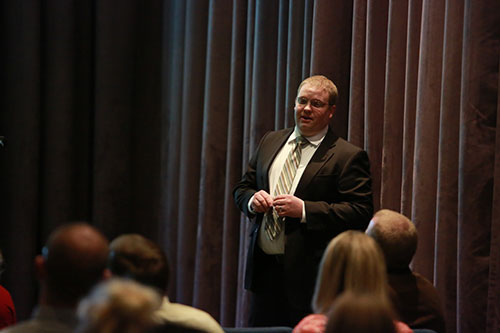
Scott Potter and Kim Weaver, PhD*
Department of Physical Science
Abstract
Coal Creek, which drains from the Cedar Breaks amphitheater and Ashdown Gorge Wilderness Area (AGWA), has been observed to have limited biodiversity with limited insects, fish, and algae in the main tributary Ashdown. Water sample analysis of samples collected in AGWA included trace metals by ICP-MS, chlorophyll by Spectrofluorometry, mineral and anion concentrations by Ion Chromatography, and the specific conductance which relates to total dissolved solids. High concentrations of metals were found in samples collected from different areas of Ashdown as well as its tributaries in the upper portion of the AGWA. Crow’s Creek which exhibits visibly higher levels of biomass generally showed lower concentrations of metals as well as a visible clarity of water indicating less suspended material. Ion chromatography showed slight variation in anion concentration over the collection time for various tributaries. The values observed for conductivity (μS) varied throughout the tributaries, but there was a consistently high value in Spring Creek indicating a high concentration of total dissolved solids. This project focused on a detailed understanding of the water chemistry of the area over the duration of a year (Fall 2012-Fall 2013). This information is intended to validate further investigation ultimately leading to a comprehensive environmental analysis and understanding of the water chemistry, geology, and biology of the Coal Creek area.
Vasoactive effects of Eschscholzia californica extract on frog tongue arteriolar smooth muscle
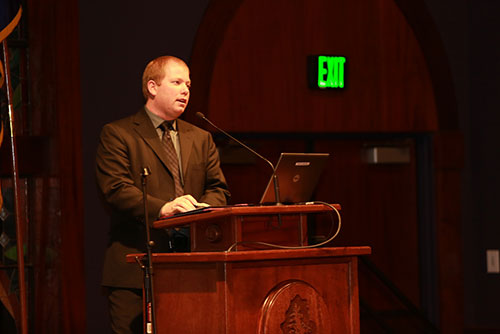
Micah Keeno and David Potter, Matthew Weeg, Ph.D.* and Mary Jo Tufte*
Department of Biology
Abstract
Natural herbs have a long medical history of being used to treat everything from minor ailments to terminal diseases. Several claims have been made on the medicinal effects of the California poppy (Eschscholzia californica); including that essential oil extracts can be used to relieve migraines. Migraines are extremely debilitating and often make it difficult for those who suffer to function normally. Despite claims that E. californica provides migraine relief, there has been no scientific study to support this effect or that explores a physiological mechanism of action. Because some types of migraines are caused by blood vessel spasms in the brain, we hypothesize that the compounds in the extract of E. californica have a stabilizing effect on the blood vessels of an organism, which may provide migraine relief. To test this, we have collected whole plants of E. californica and dried them to obtain biomass. A separation protocol using maceration (grinding) and direct distillation will be used to extract plant materials. This extract will be applied to the tongues of frogs, and blood vessel diameter will be measured to observe any vasoactive reactions. Should physiological activity be found, gas chromatography mass spectroscopy (GCMS) will be used to determine what specific compounds, or combinations of compounds in the plant, are causing this effect. This research could potentially offer more insight to, and provide validation for, the alternative treatment methods being used to treat migraines and possibly improve the quality of life for migraine sufferers.
The stability of a semi implicit numerical scheme for a competition model arising in Math Biology
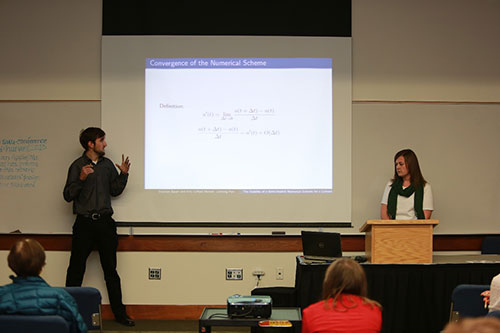
Brennon Bauer, Amy Gifford, Jianlong Han, Ph.D.*
Department of Mathematics
Abstract
We studied the Lotka-Volterra competition model, which can be applied to Math Biology. We propose a Semi-Implicit numerical scheme, which guarantees that the populations are always positive. Also we prove that the numerical scheme is uniquely solvable, and is unconditionally stable.
Patterning Supported Lipid Bilayers with Magnetic Tweezers
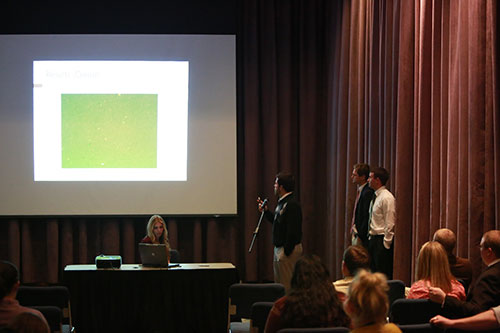
Travis Bulloch, Madeline Parson, Tyler Argyle, Chad Parson, and Chris Monson, Ph.D.*
Department of Physical Science
Abstract
The arrangement of components within cell membranes can be extremely important, particularly in cell communications. For example, in an immunological synapse proteins are arranged in a bull’s-eye pattern, with specific proteins in the inner and outer regions of the bull’s-eye. The ability to generate such patterns in bilayers could see applications in many areas of biology. Our goal is to take an initially unpatterned supported lipid bilayer (model cell membrane) and use magnetic tweezers to generate patterns. We first calibrated the magnetic tweezers device and now we are working on pattern formation using the magnetic tweezers.
The role of hypoxia-inducible factor 1 in the upregulation of aquaporin 1 channels in pulmonary arterial smooth muscle cells
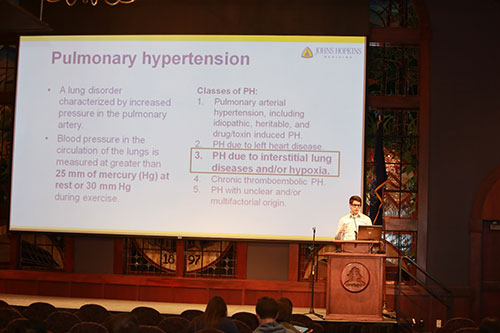
Stephan Maman, Samara Baksh, Xin Yun, Haiyang Jiang, Larissa Shimoda*
Department of Johns Hopkins School of Medicine – Pulmonary and Critical Care Division
Abstract
Pulmonary arterial smooth muscle cell (PASMC) migration contributes to vascular remodeling, a hallmark characteristic of hypoxic pulmonary hypertension. Aquaporin-1 (AQP1), a membrane water channel protein, plays a key role in PASMC migration when the cells are exposed to hypoxic conditions. Additionally, AQP1 is present at elevated levels in PASMCs that have been exposed to hypoxia. In our study, we investigated AQP1 expression during hypoxia. Previous studies showed that AQP1 is a direct target of the transcription factor, hypoxia-inducible factor 1 (HIF-1), in hemangioendothelioma cells. Therefore, we hypothesized that HIF-1 may directly upregulate AQP1 in PASMCs during hypoxia. Alternatively, AQP1 could be indirectly regulated by HIF-1 because: 1) HIF-1 promotes the transcription of TRPC1 – a calcium channel; 2) AQP1 contains a putative calcium binding site; and 3) an increase in intracellular calcium concentration ([Ca2+]) in PASMCs is observed under hypoxic conditions. To test our hypothesis, we utilized PASMCs freshly isolated from rat small diameter intrapulmonary arteries and cultured to 50% confluence. In order to verify that the cells were PASMCs, intracellular calcium was measured during exposure to KCl. Using PCR and immunoblot techniques, we determined the amount of AQP1 mRNA and protein in isolated rat PASMCs in which HIF-1 was activated in vitro using hypoxic conditions, as well as known HIF-1 upregulators such as DMOG and CoCl2. Our results show that neither AQP1 mRNA nor protein levels increased after exposure to HIF-1 activating conditions. Thus, we conclude that HIF-1 does not directly regulate AQP1 in response to hypoxia in PASMCs.
Green Electrical Power Through Cycling
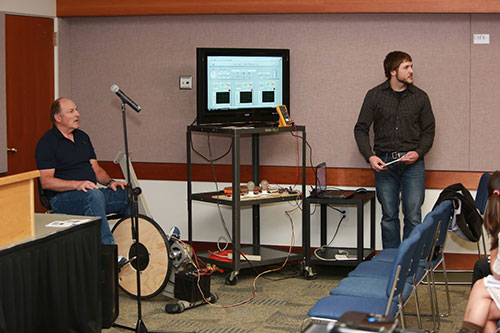
Tyson Weeda, and Dave Ward*
Departments of Engineering Technology & Construction Management
Abstract
In today’s society we have constant concerns on energy usage and producing green house gases. There are many companies making eco friendly power products that convert the mechanical energy created by a bike over to an electrical energy. Even competitive cyclists use watt meters to truly determine their cycling output. The concept we have created is just that. We will be using the mechanical energy created by pedaling on an exercise bike and converting it to an electrical energy by using a car alternator. We will then be installing and programming a computer interface that will display items such as RPM, graphs of voltage, amperage, and generated power. It will also allow the user to adjust the electrical load on the alternator. This project makes a great demonstration of how much work it actually takes to power all of our electronic devices we use every day.
Antimicrobial Properties and Composition of Essential Oil Isolated from Ericameria linearifolia (Asteraceae)
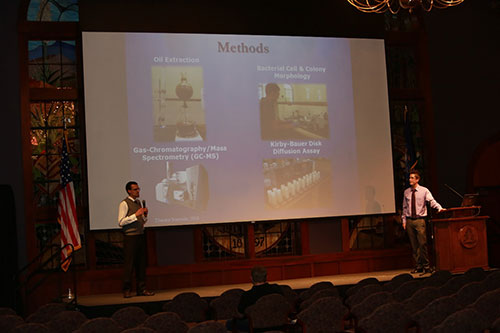
Preston Manwill, Nathan Heyborne, and Terri Hildebrand, Ph.D.*
Department of Biology
Abstract
Plants produce myriad secondary metabolites (essential oil) that play a role in ecological interactions. Species evolve unique mixtures of organic compounds due to strong selective pressures that act on metabolic pathways. Few studies have investigated the antimicrobial properties of secondary metabolites that evolved against soil microbes associated with native plants. The essential oil of Mojave goldenbush (Ericameria linearifolia), a shrub native to the Intermountain West, was characterized and its bacteriostatic abilities against root associated and non-root associated bacteria morphs were examined in this study. We hypothesized E. linearifolia oil would act as a greater growth inhibitor against native soil bacteria with which it has evolved than against bacteria from non-associated soils. Secondary metabolites were extracted using steam distillation and analyzed with gas chromatography mass spectroscopy. A Kirby-Bauer assay tested presence, size and retention of inhibition zones (IZ) produced against soil bacteria. The essential oil of E. linearifolia contained twenty secondary metabolites, two of which, limonene and sabinene, constituted greater than fifty percent of the oil. Presence and retention of IZ produced by E. linearifolia metabolites varied significantly by community association and bacteria morph. The hypothesis was supported by IZ that were largest against bacteria cultures isolated from soil that surrounded Mojave goldenbush roots and least effective against cultures isolated from non-root associated soil. Our findings suggest that secondary metabolites of E. linearifolia have evolved to specifically prevent negative interactions with bacteria most associated with the plant.
Explaining why NBA Franchises Move
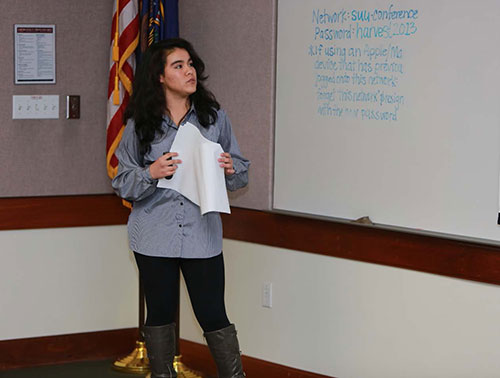
Merly Cruz, David R. Tufte, Ph.D.* and Sarah M. Duffin, Ph.D.*
Department of Mathematics and Department of Economics and Finance
Abstract
Professional sports fans regard franchises as belonging to a city, but franchises are private firms. We explore factors that make franchises move, such as national economy, size of the metropolitan area, relative size of the metropolitan area, and team record. We investigate using the statistical models of least-square regression (which is inefficient/inferior) and probit/logit.
Reactivation of conjugate fractures in the Claron Formation near Bryce Canyon National Park, Utah
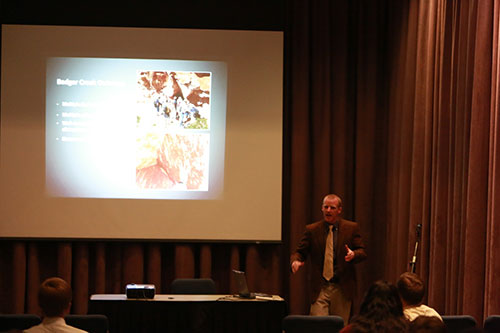
Johnny MacLean, Ph.D.
Department of Physical Science
Abstract
Bryce Canyon National Park’s Claron Formation exhibits hoodoos and fins that expose conjugate fractures. These fractures are predominantly present in the footwall of the south-directed Ruby’s Inn Thrust Fault, which lies between the two easternmost Basin and Range extensional faults. The conjugate fractures likely were produced during contraction of the Ruby’s Inn Thrust Fault during gravitational collapse of the Marysvale Volcanic Center located 40 to 60 kilometers to the north. At Badger Creek immediately west of Bryce Canyon National Park, well-preserved exposures of slickenlines and structural steps on conjugate fracture surfaces allow a paleostress analysis. Results indicate the latest motion along the conjugate fracture surfaces was extensional. Thus, the conjugate fractures produced during the Ruby’s Inn Thrust Fault contraction provided zones of weakness for reactivation during Basin and Range extension.
Native Grass Survivability Study in Utah’s Nation Forests
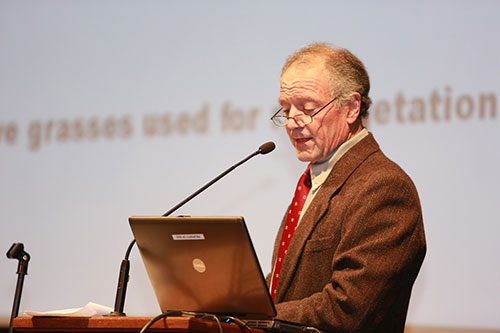
Ron Martin, Ph.D.*, Kelly Memmott, Ron Rodriguez
Department of Biology
Abstract
Currently, non-native grass species are used to revegetate Utah’s National Forest following wild-fires, logging and other destructive forces. Non native grasses are used because: a) Large quantities of seeds are readily available, c) they compete well with non-desirable native grasses such as cheat-grass, d) they have good survivability, and e) they survive well in the diverse and arid Utah Environment. This study is part of a long term project to begin re-seeding Utah’s National Park with native grasses. In this study we determine which of Utah’s historical native grasses has the highest survivability levels three years following their transplantation in the Forests. Plots were established in several locations across the large and uniquely geologically diverse expanse of Utah’s National Forests. Data of the five top performing grasses will be presented.
Mining Student Responses To Learn Answer Models: A case Study Using Data From An Introductory Programming Course

Cecily Heiner, Ph.D.
Department of Computer Science and Information Systems
Abstract
Intelligent tutoring systems have shown definite promise as personalized learning assistants that can increase learning by as much as a standard deviation over classroom teaching. However, typically they are expensive to build, requiring extensive technical and educational expertise and they are often unwieldy to develop and deploy, with simple modifications often requiring weeks of time to develop and favorable deployments requiring months of negotiations. Effective formative assessments of student knowledge during lectures and class discussions for a programming class are an often neglected part of computer science pedagogy. This talk introduces a tool called the studentsRespond system to collect student responses and build models of student work in computer science classes that does not compile using expressions with wildcard and disjunction operators. Five models, one for each of five prompts, based on a total of 38 correct responses are included. The analysis is run offline, but theoretically the data labeling task is simple enough to be completed by a typical instructor during classroom instruction.
The Big Mountain’s Little Brother: Geologic secrets of the Kaiparowits Plateau
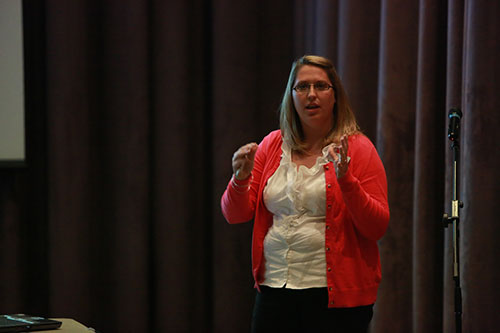
Jennifer Hargrave, Ph.D.
Department of Physical Science
Abstract
The Kaiparowits Plateau is one of the “steps” in Utah’s Grand Staircase. Today, the region’s spectacular geologic wonders bring a myriad of visitors. This topographic expression is a result of ~70 million years of geologic events. Some of the clues to this different world are found in the rocks of the Kaiparowits Formation. The section of this formation exposed within the Grand Staircase-Escalante National Monument, Utah, are highly fossiliferous, including fossil plants, invertebrates, fish, amphibians, reptiles, and mammals, many of them new to science. The formation is composed of over 850 m of conglomerates, sandstones, and mudstones. The general section has been measured and described as fluvial and floodbasin deposits on the Cordilleran foreland basin. Several geologic and paleontologic research projects are underway, including the description of new fossil material. However, the size and richness of the formation demands much more attention. Many other opportunities to be a part of this study area are available, such as determining the stratigraphic position and age of quarries, the detailed sedimentology of fossil quarries, and the designation of smaller-scale environments of deposition.
Antimicrobial Properties of Hydrosols Isolated from Anthoxanthum (Poaceae) Against Soil Bacteria
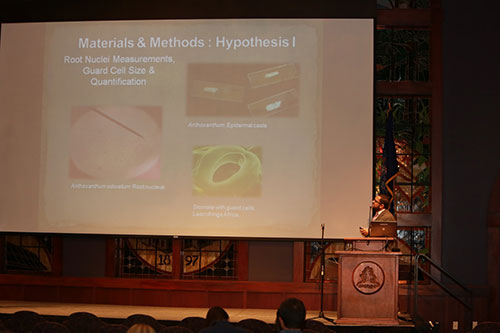
Preston Manwill, Harsh Kansagra, Terri Hildebrand, Ph.D.*, Mary Jo Tufte*, and David Tufte, Ph.D.*
Department of Biology
Abstract
Members of Anthoxanthum (sweetgrass) have a history of ceremonial and medicinal use. Coumarin, a secondary metabolite produced by the grass, is an anticoagulant and antimicrobial agent. Antimicrobial properties of commercially available European A. odoratum metabolites have been nominally investigated, but no North American species have been studied. Additionally, European sweetgrass is purported to be available in both diploid and polyploid strains. Our research objectives were to: 1) determine if ploidy level strains do exist, and 2) investigate secondary metabolite production and evolution in commercial strains and A. hirtum, a Great Basin native. Using epidermal casts and fuschin staining, differences in guard cells and nuclei were surveyed. Secondary metabolites from the A. odoratum strains and A. hirtum were obtained through steam distillation and a vacufugation protocol that concentrated hydrosols. GC/MS analyses characterized and quantified secondary metabolites. The secondary metabolites coumarin, dihydrobenzofuron, and dihydroactinidiolide were identified, with the first and latter greatest in A. hirtum. Significant guard cell differences between strains, as well as species, were observed. Two ploidy strains of A. odoratum were suggested. A Kirby-Bauer assay tested presence, size and retention of inhibition zones (IZ) produced against soil bacteria. Gram-staining initially characterized bacterial morphs. Secondary metabolites from the diploid strain were most effective against all bacterial morphs, but polyploid metabolites also generated and retained IZ against diploid root associated and non-root associated morphs. The native sweetgrass produced IZ only against root associated bacteria with which it had evolved. Future work will include similar studies of other North American Anthoxanthum species.
Arranging single chain magnet materials into 3 dimensional structures.
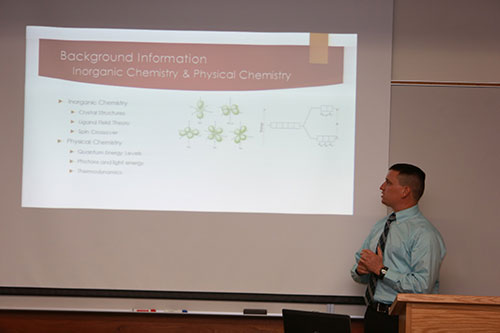
Adam Duncan and Amber McConnell, Ph.D.*
Department of Physical Science
Abstract
An important part of transition metals is their magnetic properties. The magnetic property of these metals can be manipulated by attaching different ligands. Current research is focused on using spin crossover complex ligands to build chains of transition metals where the magnetic properties can be switched on and off. We propose that the introduction of organic molecules with two binding sites will further organize these chains into 3 dimensional structures. These structures would provide more stable compounds that would not require the extremely low temperatures of single chain magnetic materials. We also expect to see that a transition in one metal will have an effect on all surrounding metals resulting in a larger effect and a greater effective range. The transition metal of interest is Iron(II), (Fe2+), with the ligand thiocyanate (NCS) used for its spin crossover abilities and the organic compounds 4,4’- Azopyridine, 1,2-Di(4-pyridyl)ethylene, and 4,4’-Bipyridyl used as organic compounds to create structure in the compound.
Connecting College Science Students to Career Success: A Holistic Approach to Return on Investment
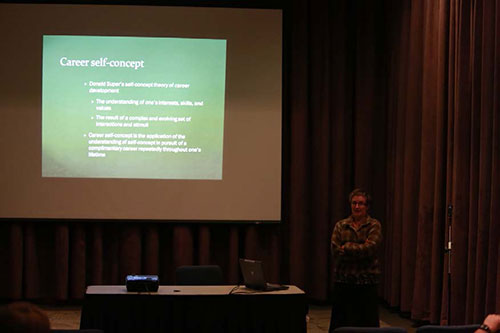
Claire Cleveland, Johnny MacLean, Ph.D.*, and Paul Spruell, Ph.D.*
Department of University Studies: EDGE-creativity
Abstract
As the costs and benefits of a college education are increasingly critically evaluated, students are seeking engagement in their field of study that will generate tangible benefits and sustainable value. Recently, Gallup scientists presented the five elements of well-being that most directly correlated with perceived success: career, social, financial, physical, and community. By applying Donald Super’s career self-concept theory as a link between students and scholarly research, the return on investment of a college education may be realized in the five elements of well-being ascribed by Gallup scientists.
Faculty and student dialogues will be facilitated to articulate career self-concept attributes and develop actionable ideas that will connect students with purposeful career self-concepts. Genuine engagement of these students with their career self-concepts will drive active participation in the student’s field of study and generate motivation toward self-directed research resulting in developmental success.
These incentives apply not only to young adults, but also to midlife career changers. As life spans increase, multiple careers will become increasingly attractive if not demanded by rapidly evolving marketplaces. By attracting these adults into the Southern Utah University community, younger students will benefit from the insights of those who have experienced career choices and their outcomes as well as expand Southern Utah University’s applicant pool. Recommendations will be presented to the College of Science and Engineering with the intended outcome of increasing the proportion of students in self-directed research at Southern Utah University and enthusiastically engaged in their career or graduate studies within one year of graduation.
